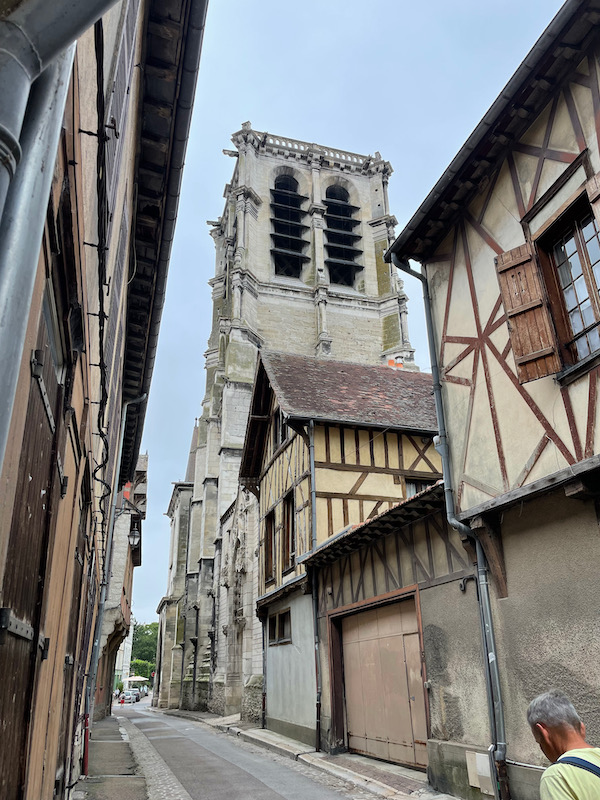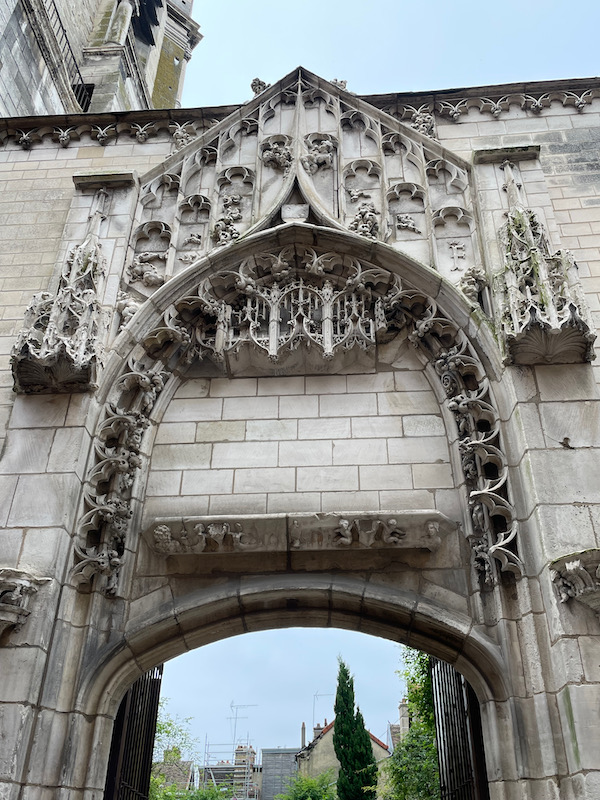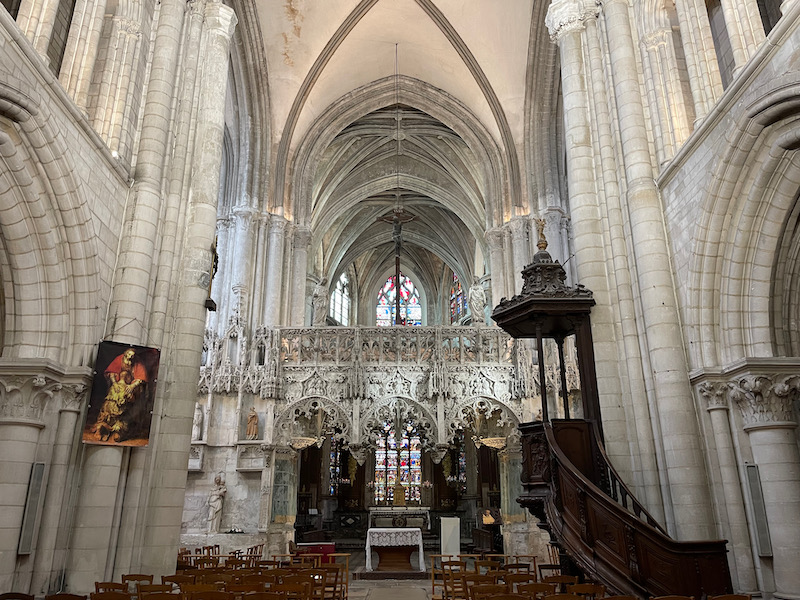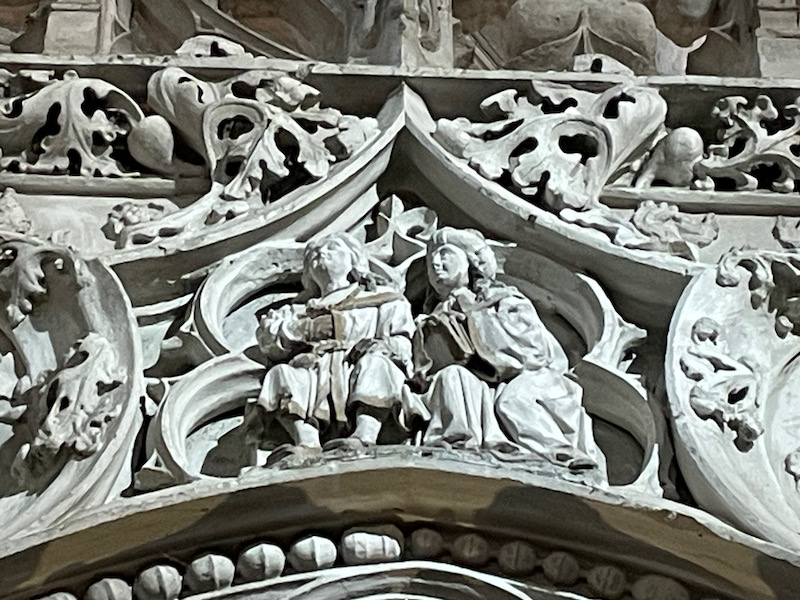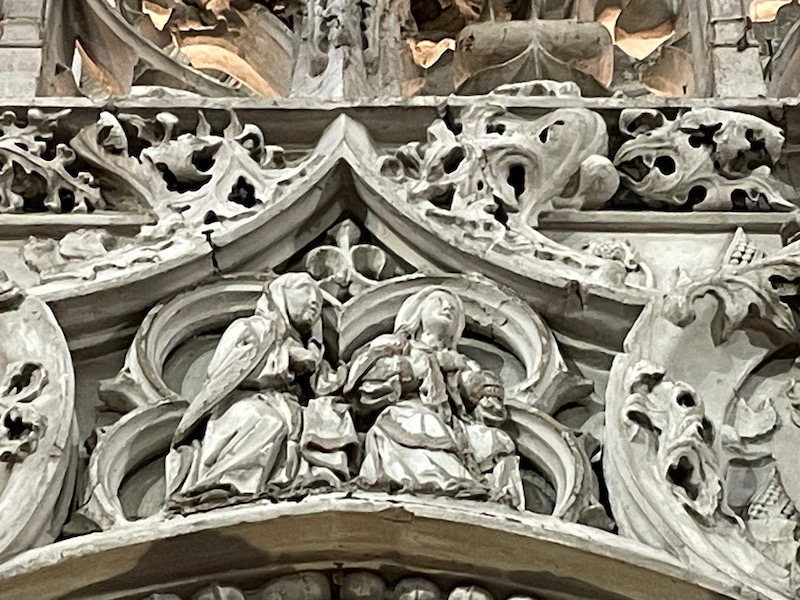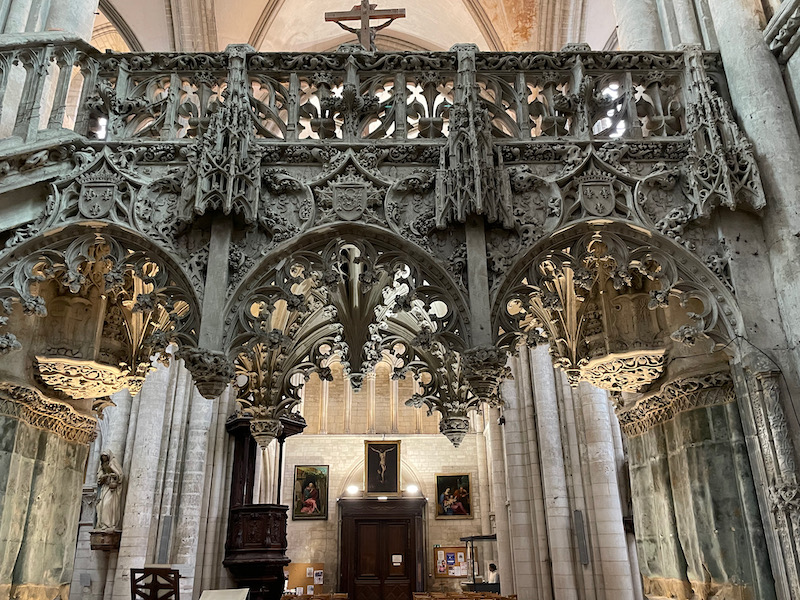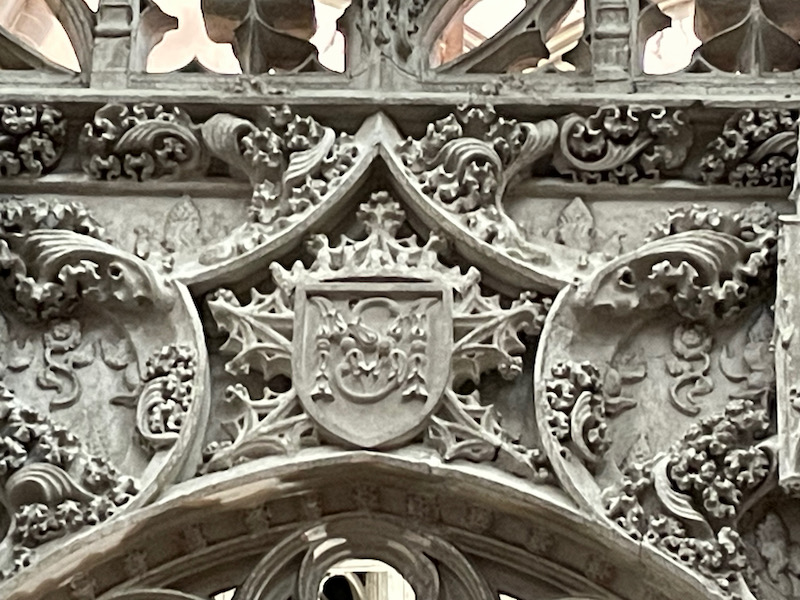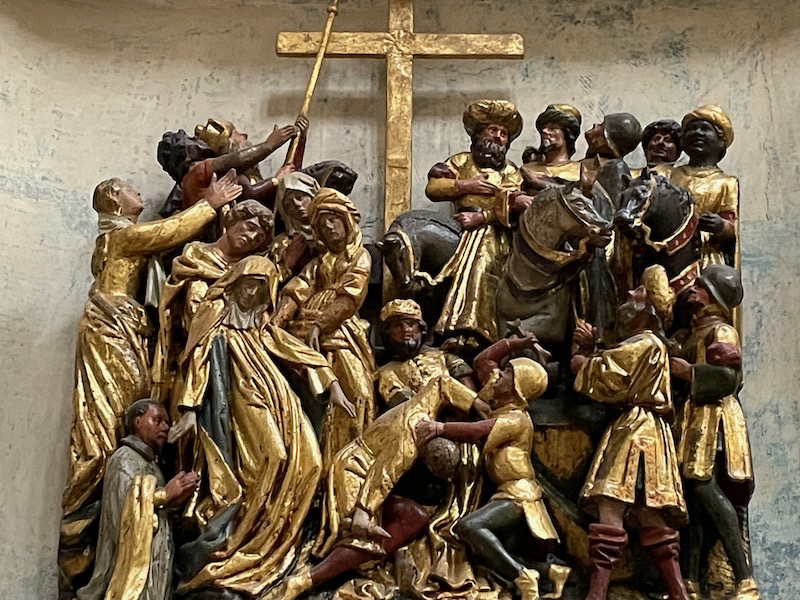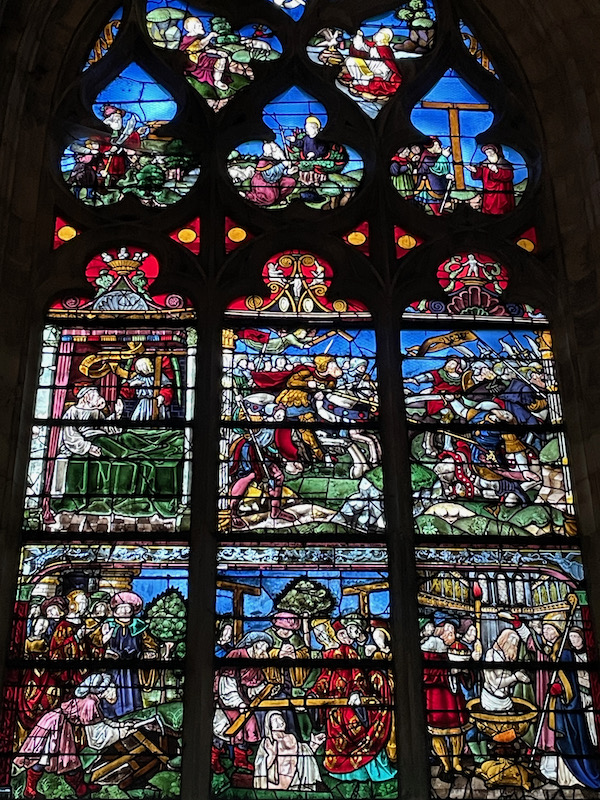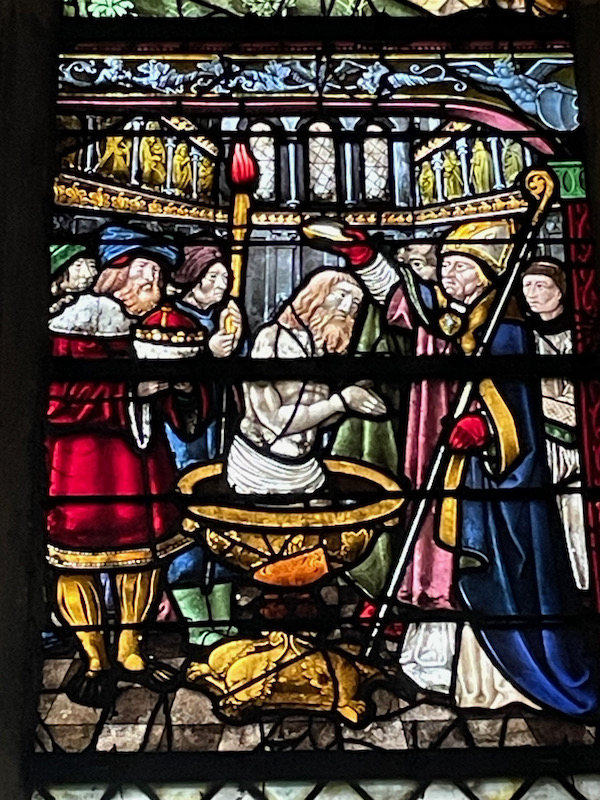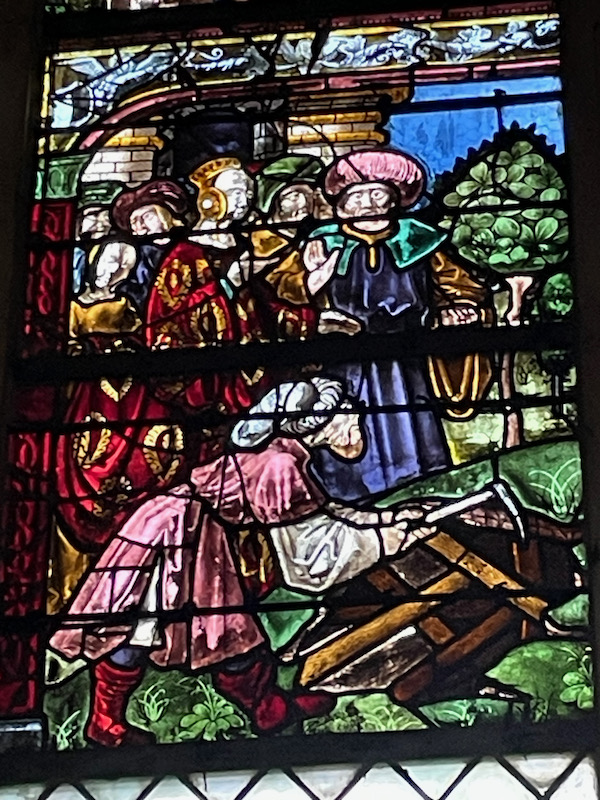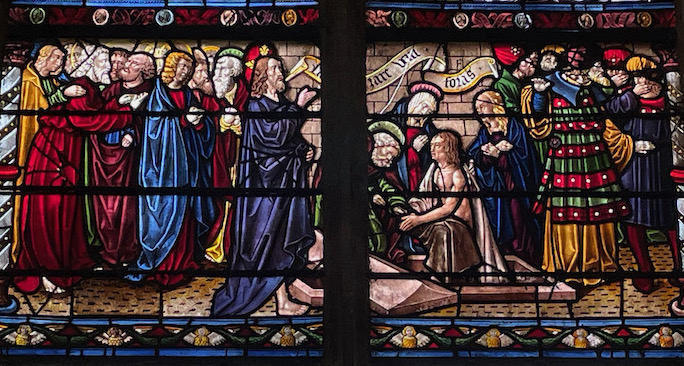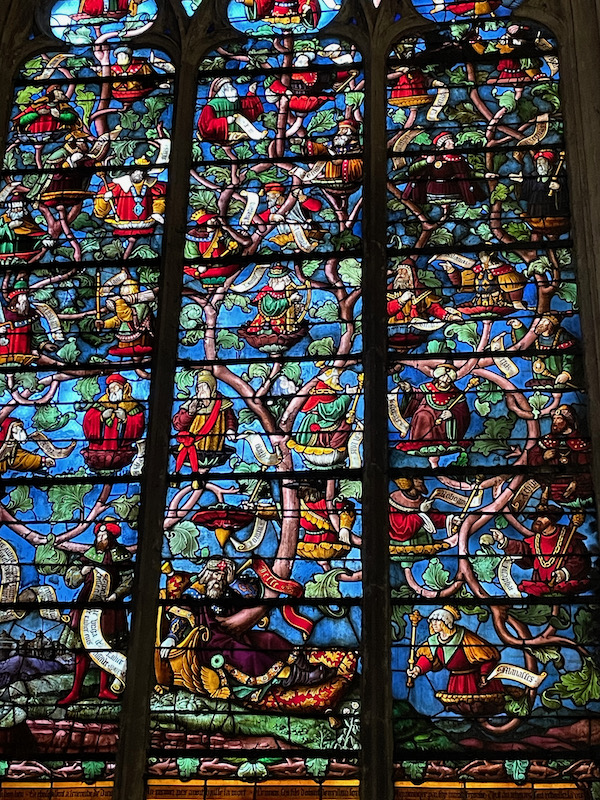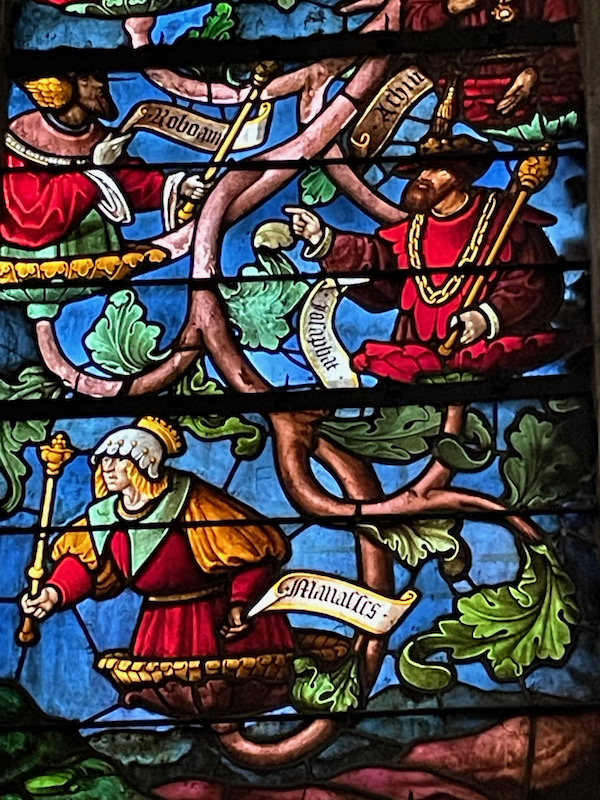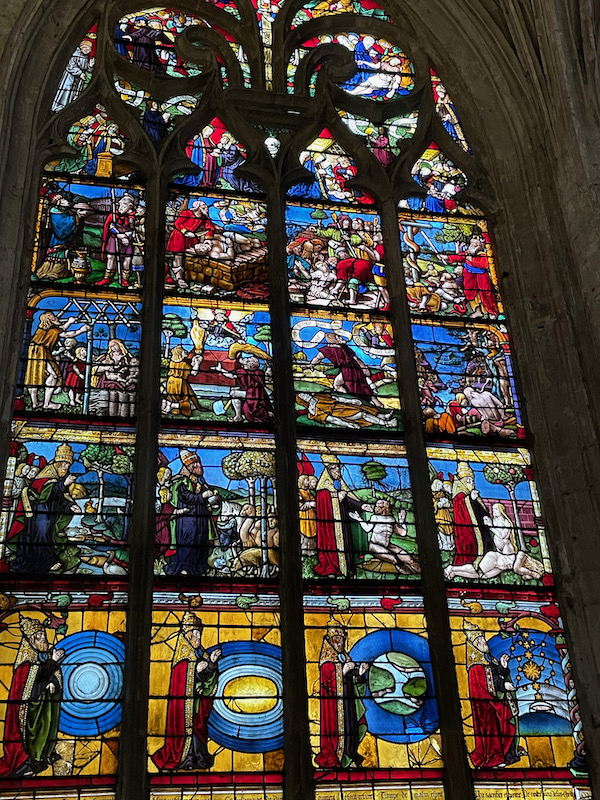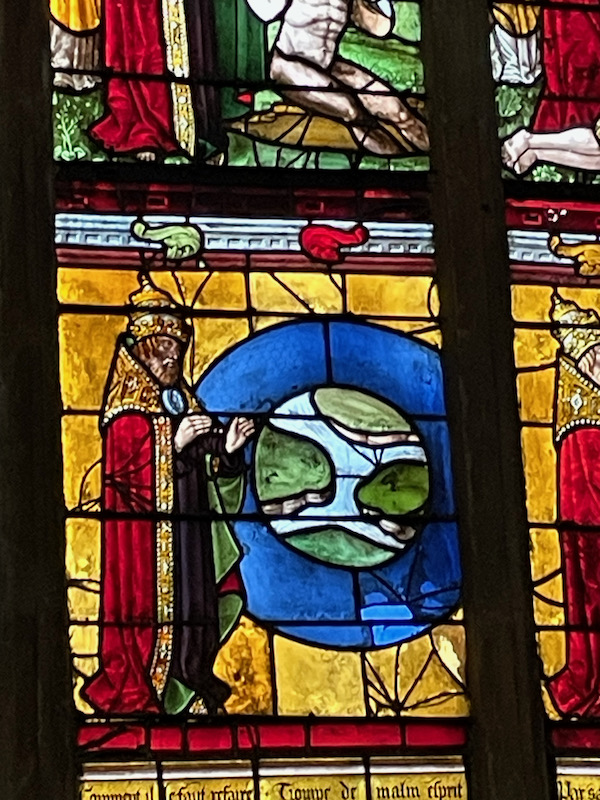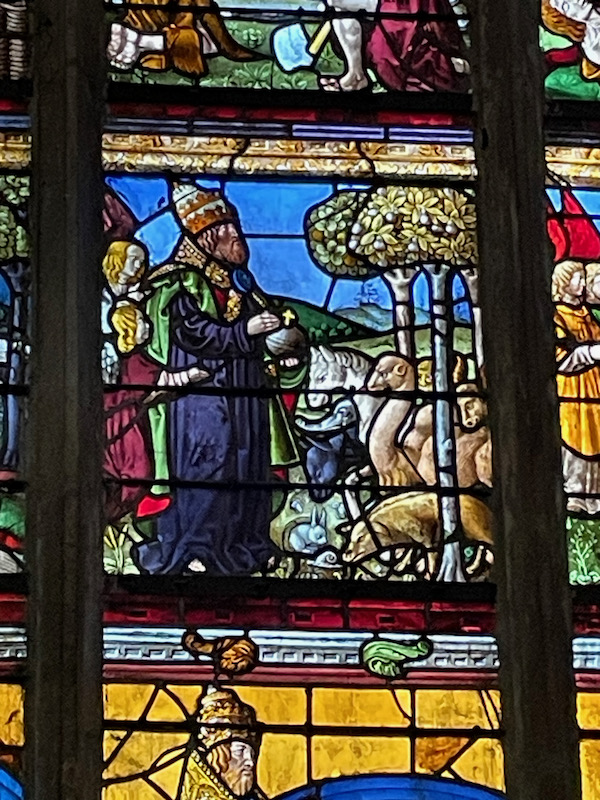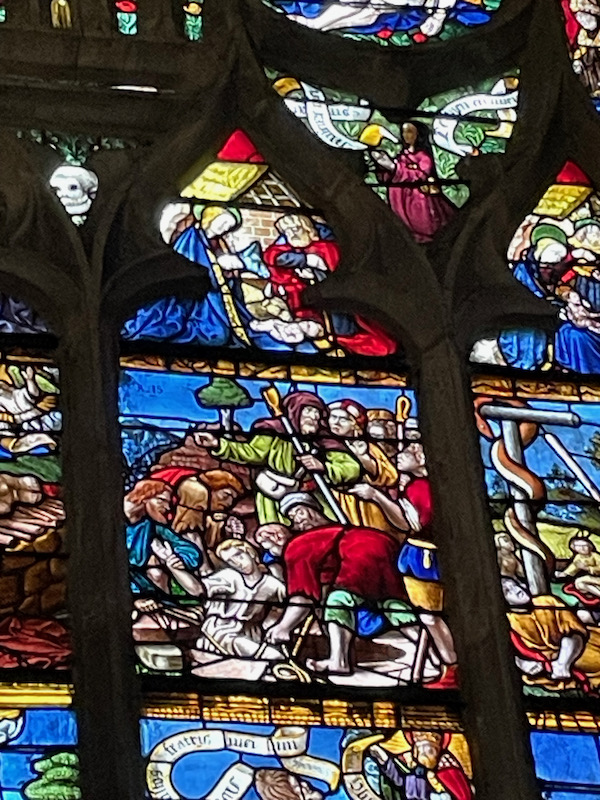Our Blog - Summer 2024 Trip - Troyes, France
The city of Troyes wasn't originally on my list of places to visit, but a friend of ours is from there, and so we decided to make it part of our trip up north this year. It is considered part of the Champagne region, so there are Champagne vineyards nearby. It is also known for andouillette sausage, which is a coarse-grained sausage made from the intestine of pork, pepper, wine, onions, and seasonings. True andouillettes are rarely seen outside France and have a strong, distinctive odor coming from the colon. Although sometimes repellent to the uninitiated, the scent is prized by its devotees. Tom has tried it several times in several different restaurants over the years and has never found a "good" tasting andouillette, so we passed on trying again here, even though it is a specialty.
As for other things, it one of the largest concentrations of half-timbered houses from the 16th century. There was a fire in 1524 but the city was rebuilt, most of the buildings being rebuilt exactly how they looked before. The richest residents chose to build their homes from fire-resistant materials, and it is this decision that gives the city its marked contrast between poorer timber-framed dwellings and the stone-built mansions of the upper classes. The city also has a wide variety of stained-glass windows.
We had stayed overnight at a nice B&B in Troyes and took the morning to walk around town. Our first stop is the Villa Gaston Viardot. It was built in 1908 in the floral Art Nouveau style. The main façade built in white stone and red brick is composed of three asymmetrical bays and three levels. Each bay is different but all three have sculptures and moldings with floral and fruit motifs. Over the top windows on the right and left are the heads of 2 female figures with long flowing hair.
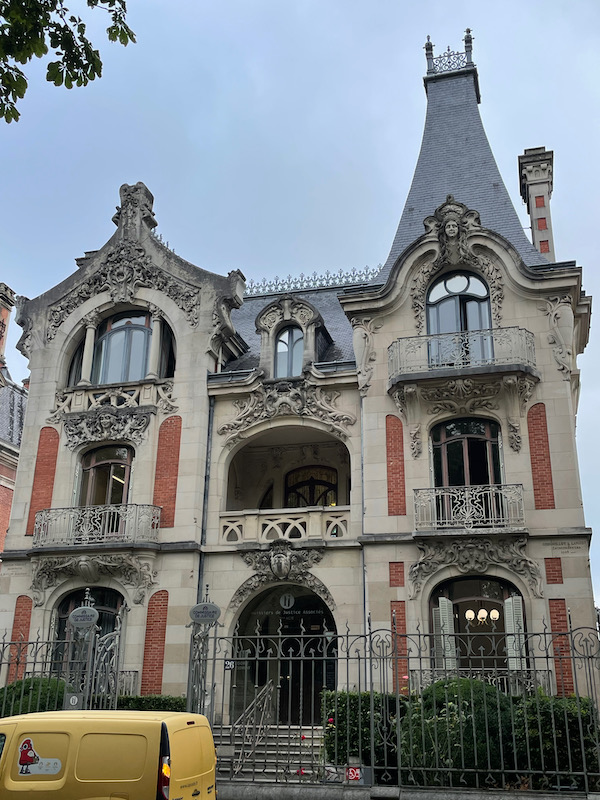
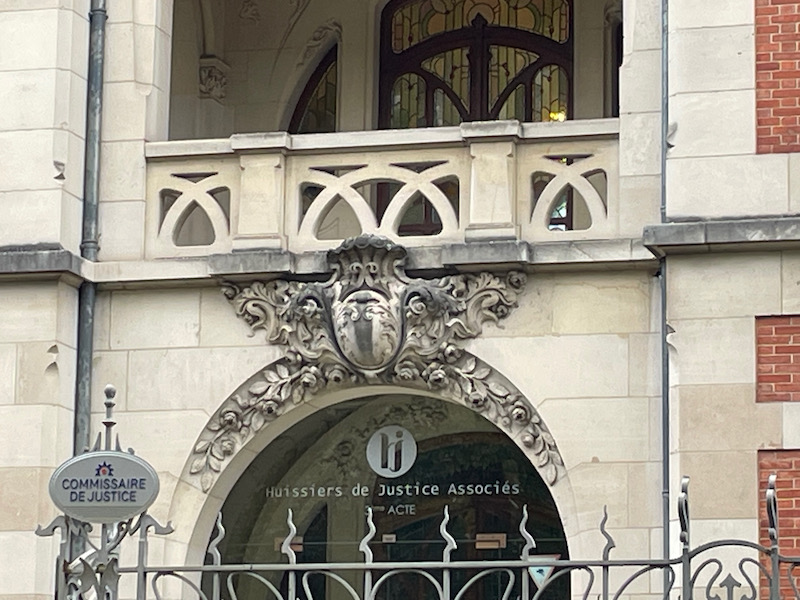
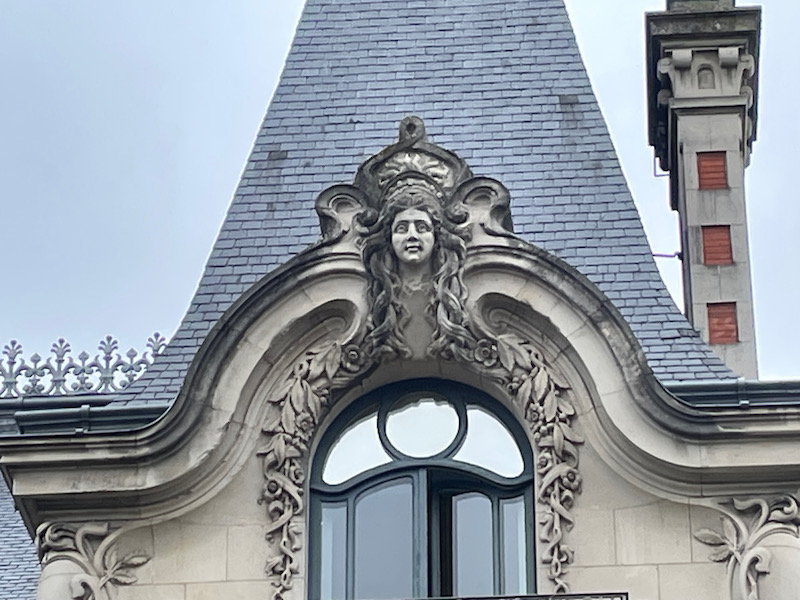
This late 19th-century building (which houses the bank Caisse d'Epargne).
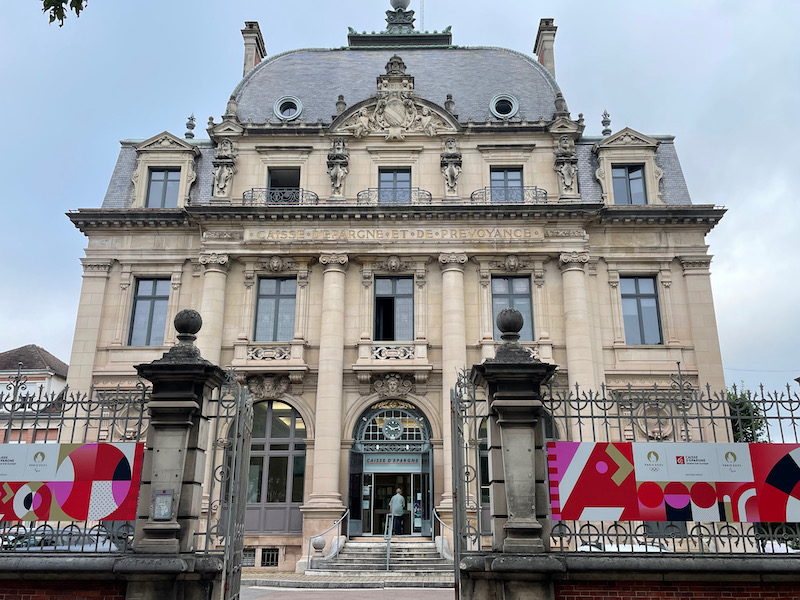
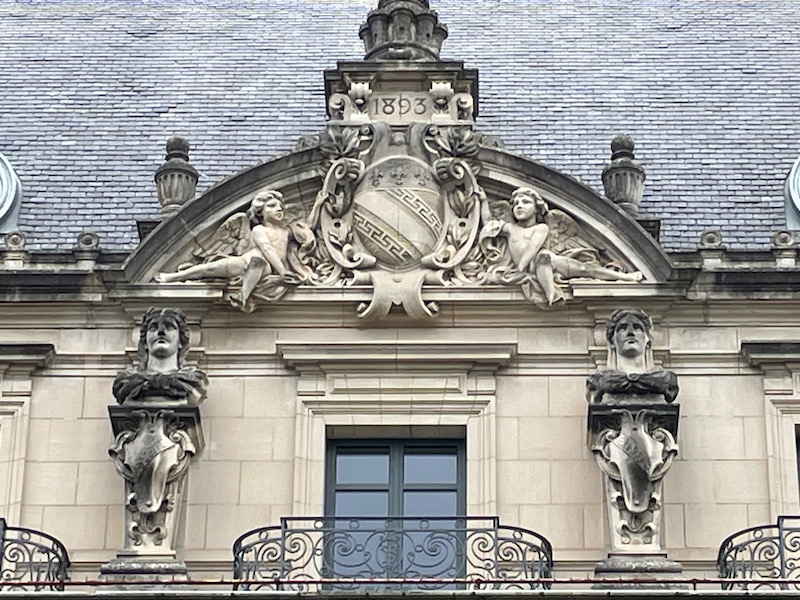
Troyes is well-known for its collection of half-timbered houses. Some are original Middle-Age/Renaissance homes while others are reconstructions after the "Great Fire" of 1524. The fire started in the house of an apothecary and burned for 26 hours with 25% of the town being destroyed. Over 1500 homes, several churches, and the Chateau of the Vicomte were destroyed. Then, the locals rebuilt their homes in the following decades after this terrible disaster. They still made their houses with oak and cob, with a triangular roof, but they added a modern touch with sober Renaissance decorations on the ends of the beams, on the corner posts and at the base of the brackets. These houses were remodeled over the years, until 1667 when a royal decision was made to cover them with a lime plaster in protection against fire. Finally, at the end of the 20th century, the houses were stripped of their grayish plaster. They were rediscovered, restored and pampered while preserved for the years ahead. It was a real metamorphosis, and they regained their colorful appearance.
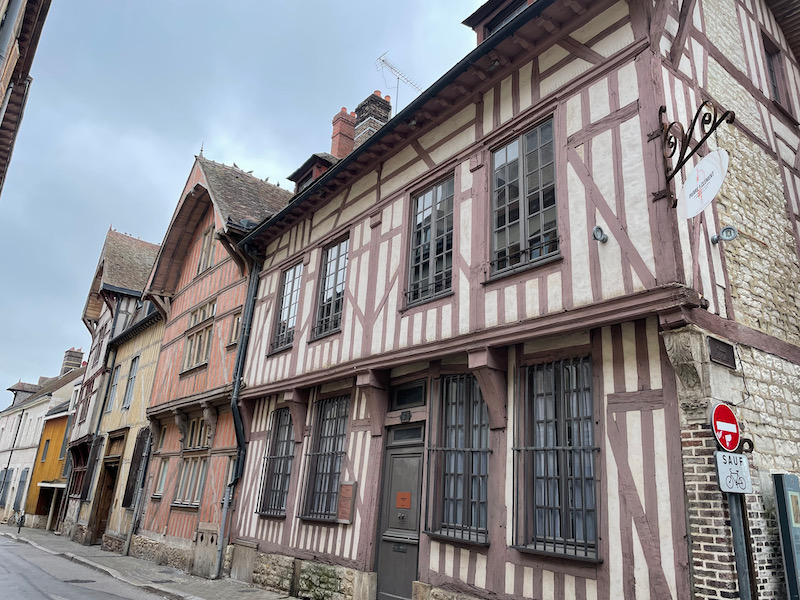
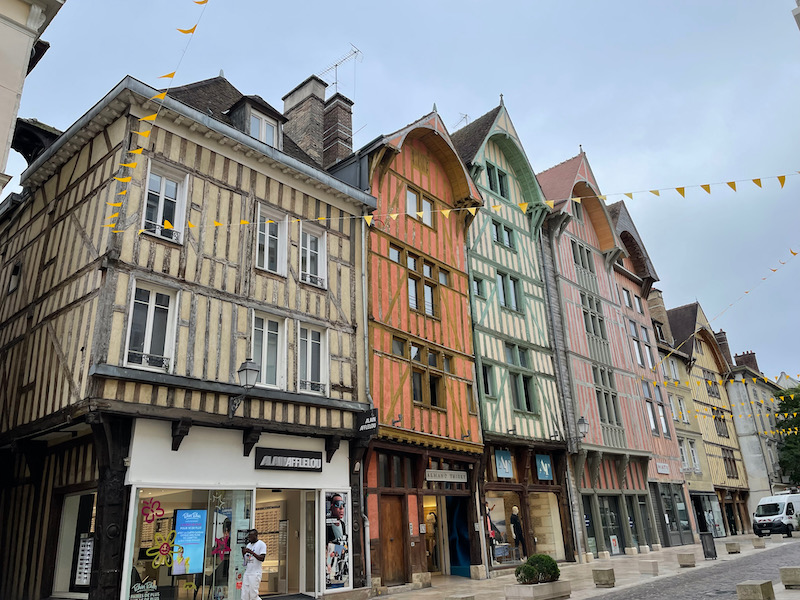
Originally Rue Maillard, this is now Ruelle des Chats or Cat Alley. The locals began calling this street Cats’ Alley in the 19th century because the adjoining roofs of its houses enabled cats to pass from one attic to the next. It is cobbled in the ancient style, just like all the streets of Troyes from the 13th century, with a central channel that allowed the inhabitants to avoid soiling their shoes by staying above this drainage feature. Some of the houses, like the 2 in the 2nd picture, are actually new construction, built piece by piece based on old postcards and engravings from the era.
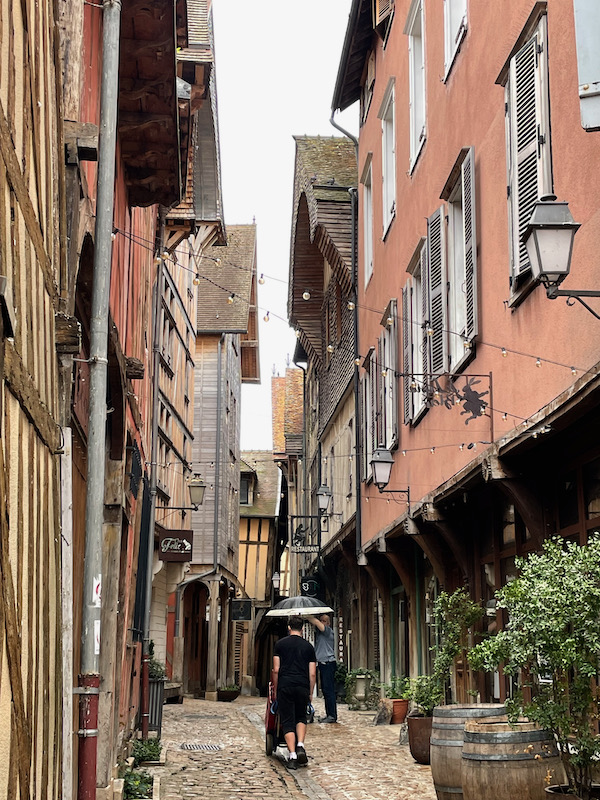
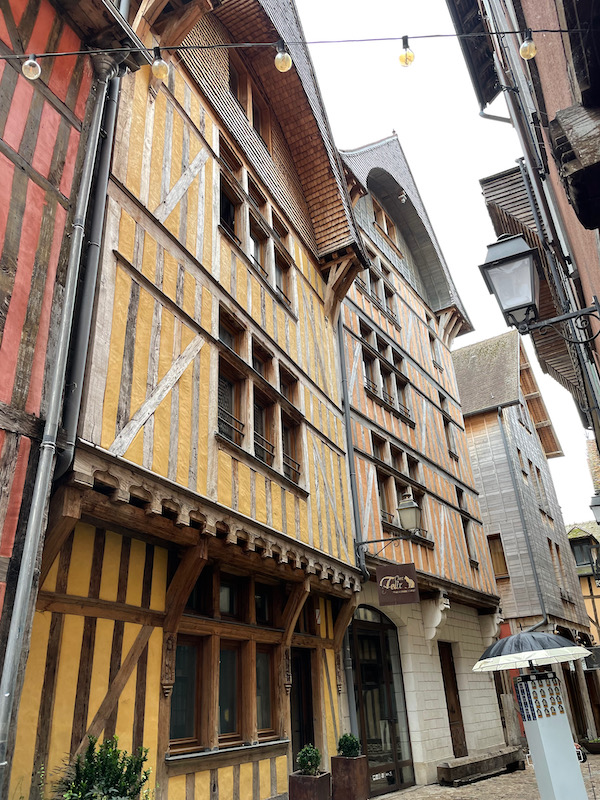
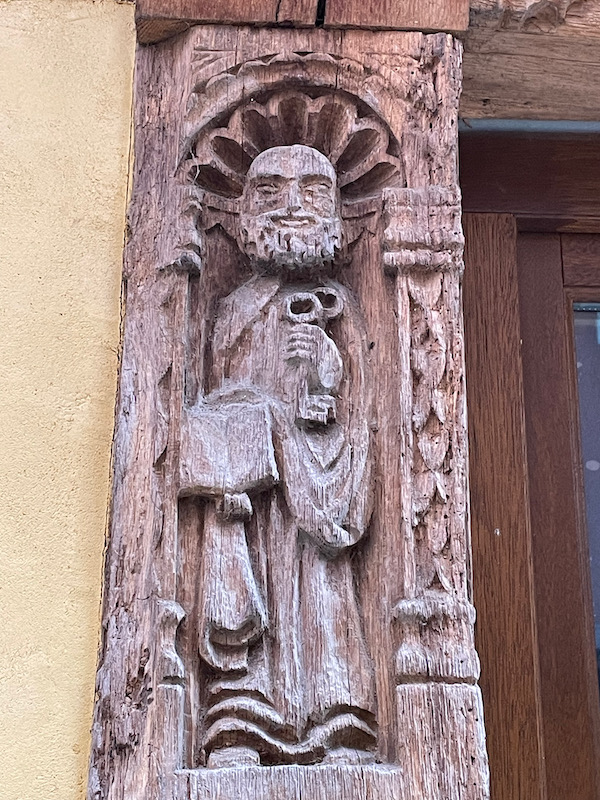
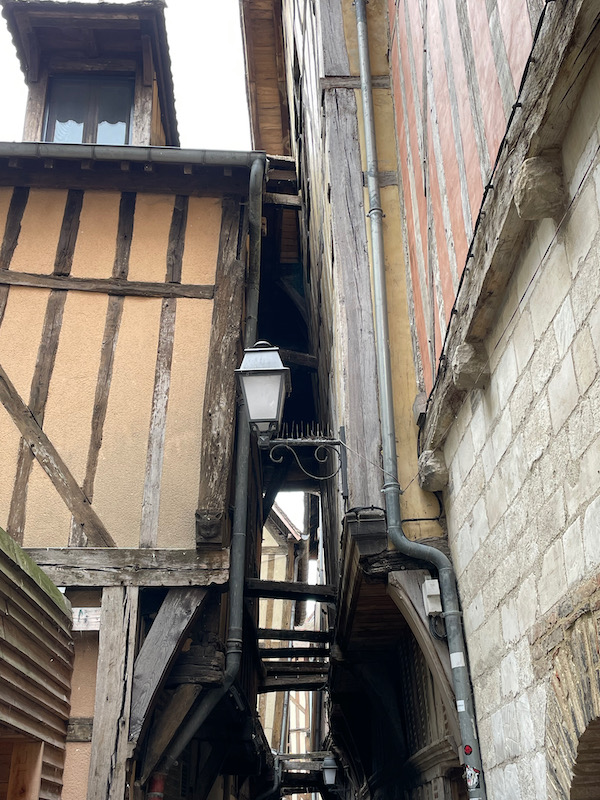
There are quite a few old wells, like this one, around town. The city of Troyes has always been linked to water. The Romans settled here because there was water, and later, water would help protect the city from fires, since it was originally built entirely of wood and straw from fires. Obviously, it didn't always protect the city, since there was the "Great Fire" in 1524. In the 12th century, water mills arrived and supplied the tanneries and draperies, and then wells started appearing in the 15th century. It was a very expensive to have a well dug so originally it was only wealthy families and churches. Eventually, the city has around 70 public wells dug. After running water arrived, around 1850, these wells eventually were destroyed. Some have been restored, like this one.
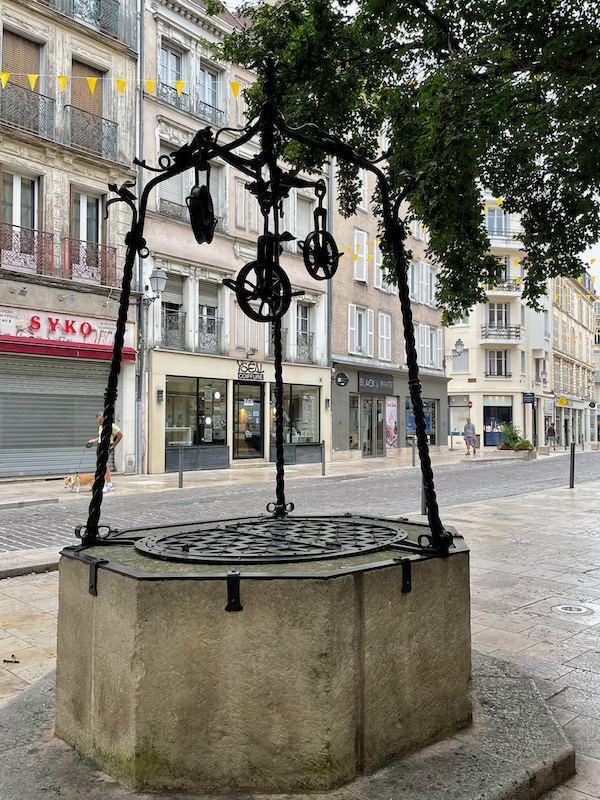
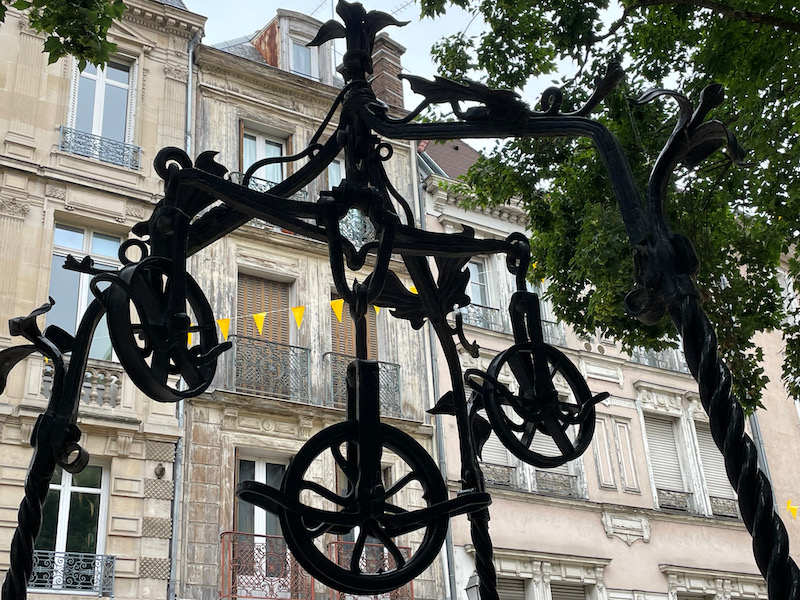
There is mention of a church at this location as early as 1189, but most of the current Saint Pantaléon Church dates from the 16th century. The parish decided to build a new church in 1516 and demolition started in 1523. However, the great fire of 1524 ravaged the building and hastened the restructuring work, allowing it to be completed in 1536. The outside of the church is rather uninspiring, although the bell tower is quite different than most.

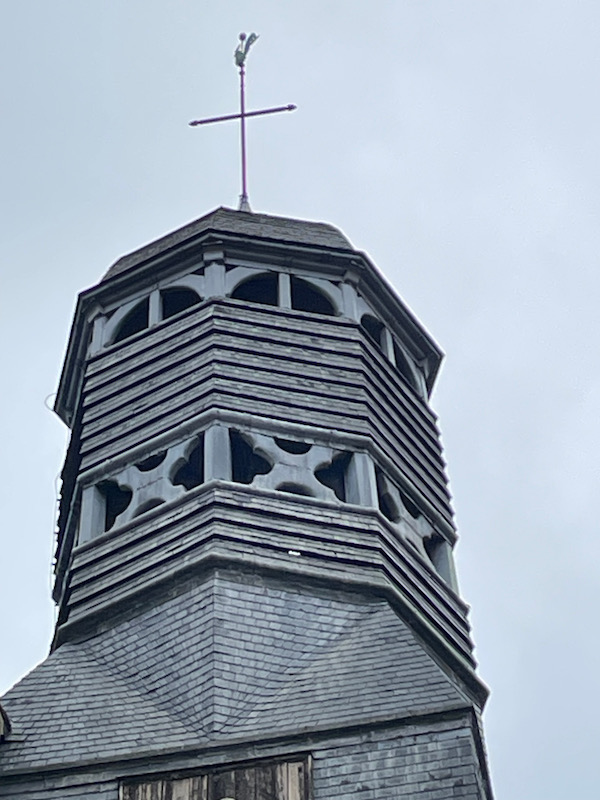
The interior is much more interesting :-) It has a wooden-boat style ceiling and a very tall nave with side aisles. An interesting note here is that it now houses an impressive collection of 16th-century statuary, since statues saved during the revolution were hidden here. Some of them are really entertaining, like this set of 2 gentlemen talking up on a balcony.
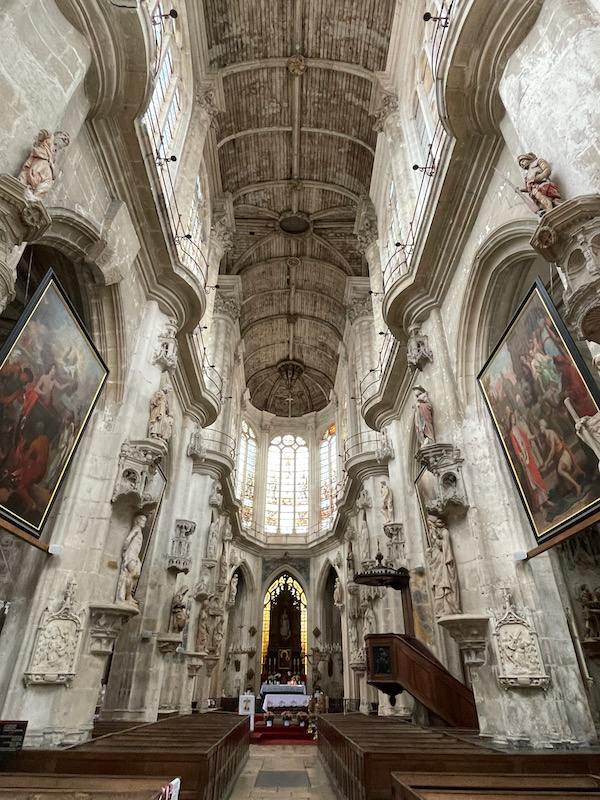
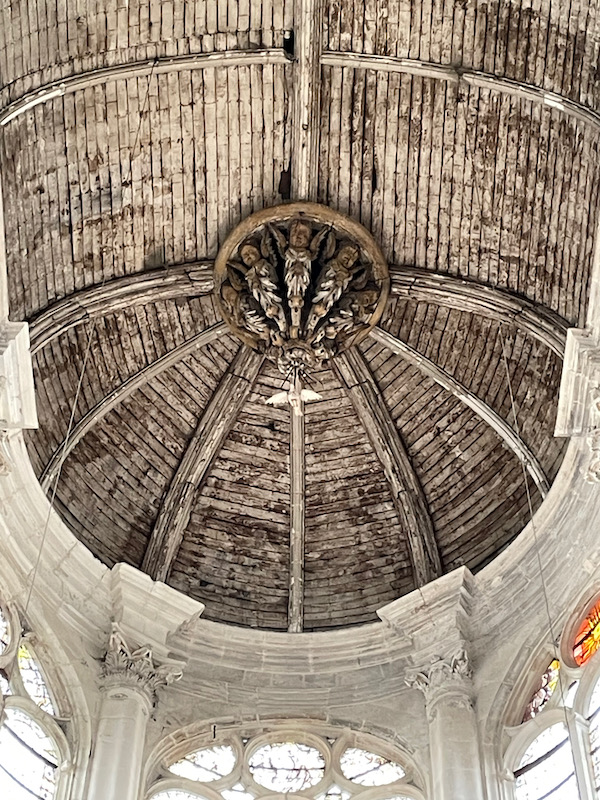
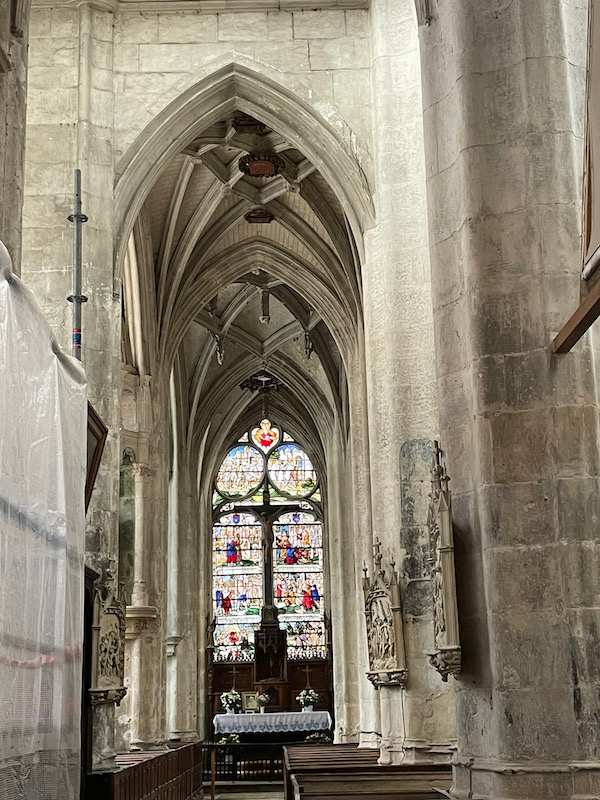
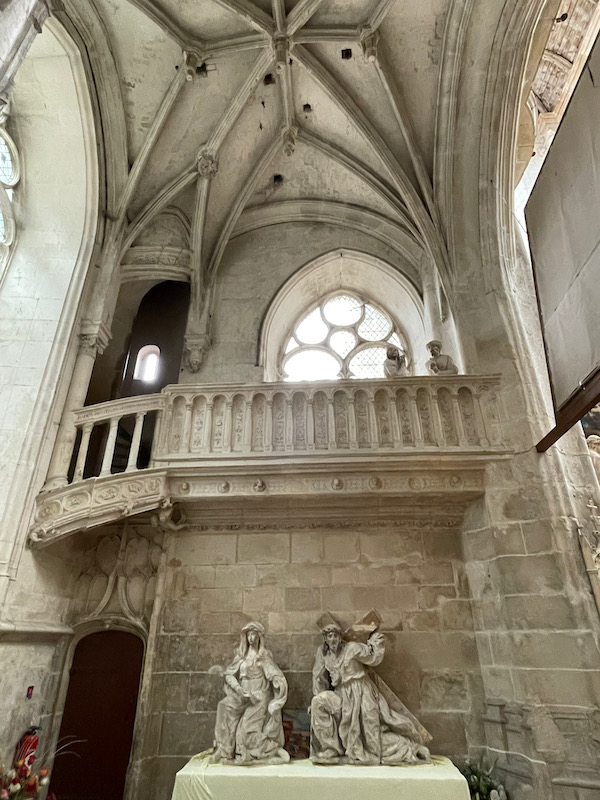
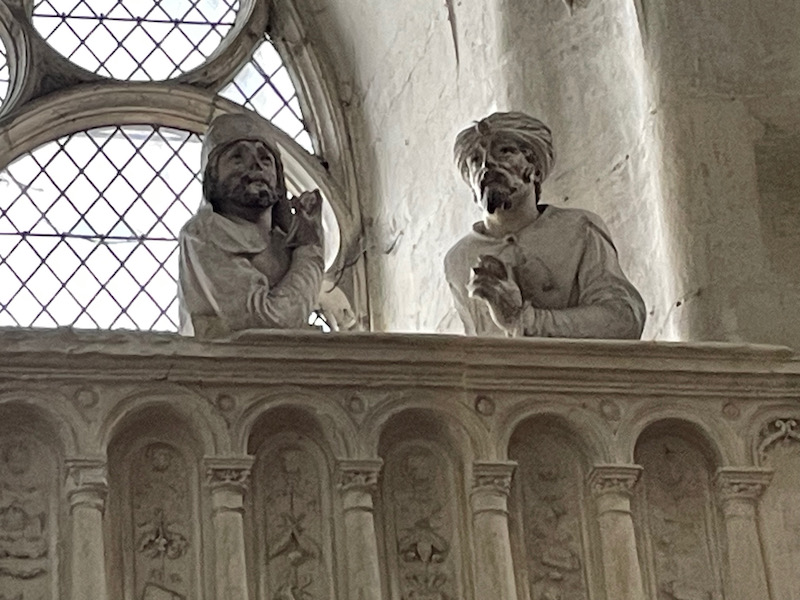
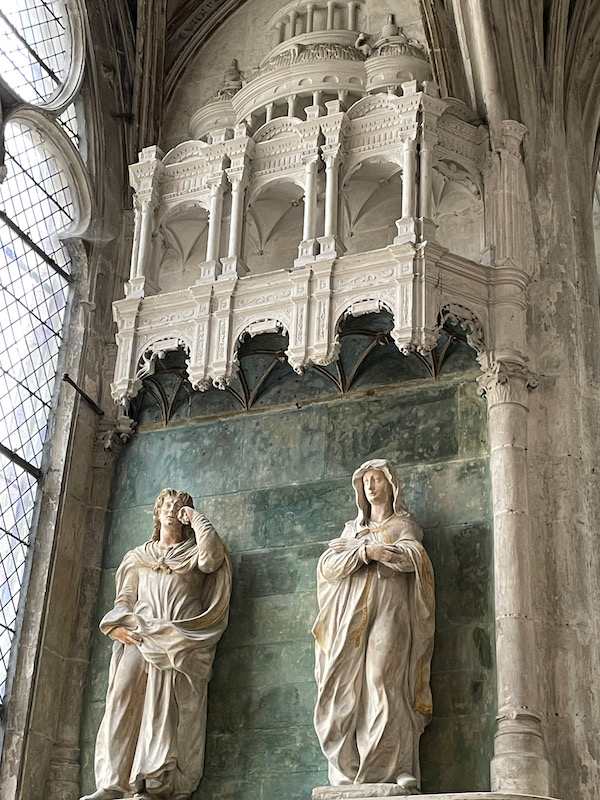
This is a polychrome statue group depicting the Arrest of Saint Crépin and Saint Crépinien (shoemaker brothers from the 3rd century who are now patron saints of cobblers) that date from the 16th century.
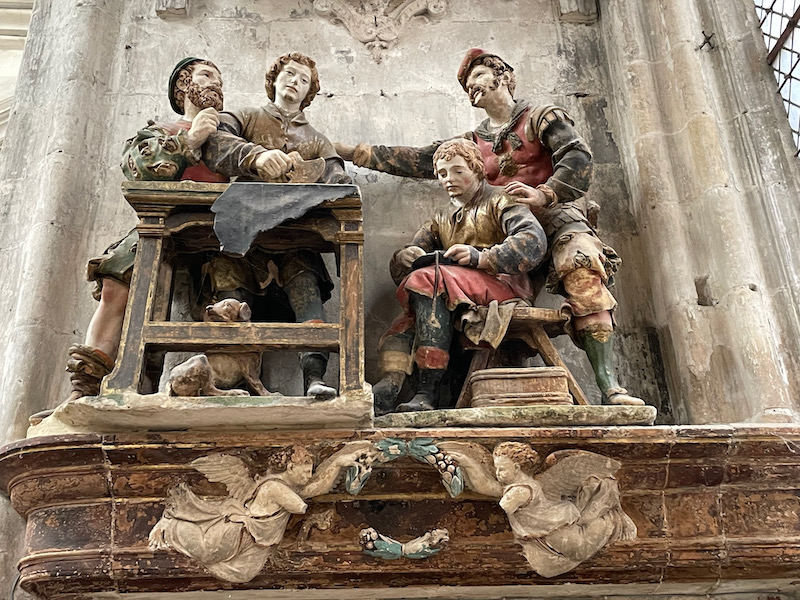
This statue has a little color remaining on it, but I was more impressed by the canopy above it.
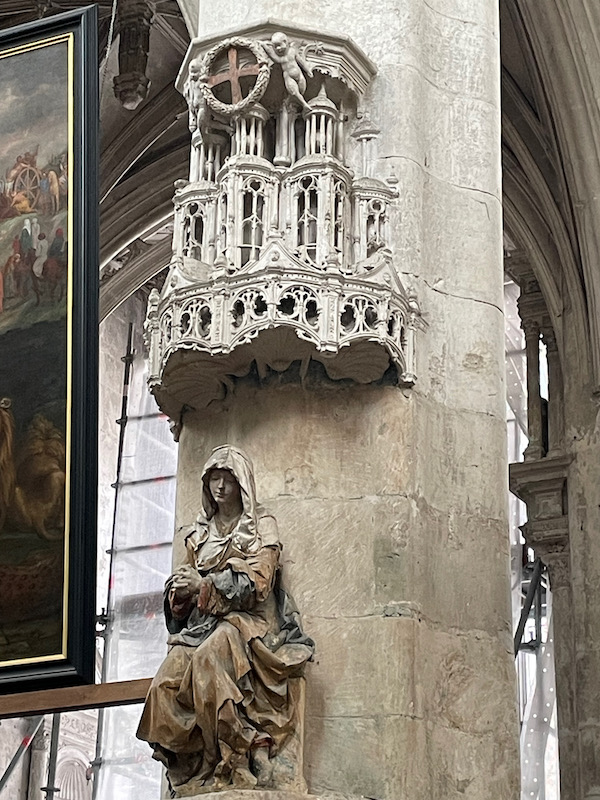
A large number of the stained-glass windows (although not all) are what are called "grisailles". Grisaille is actually a type of paint used in stained-glass windows and from the Middle Ages to the 14th century, the colors were shades of brown. Here you can see how some of these stained-glass windows are almost black-and-white or grey-scale with bits of browns and yellows in the highlighted areas. In the last one in this group, you can see the grey-white-brown-yellow windows around the statue of the Virgin Mary and Child, but then there is blue representing the sky overhead, and then blue and red in the coat-of-arms at the very top.
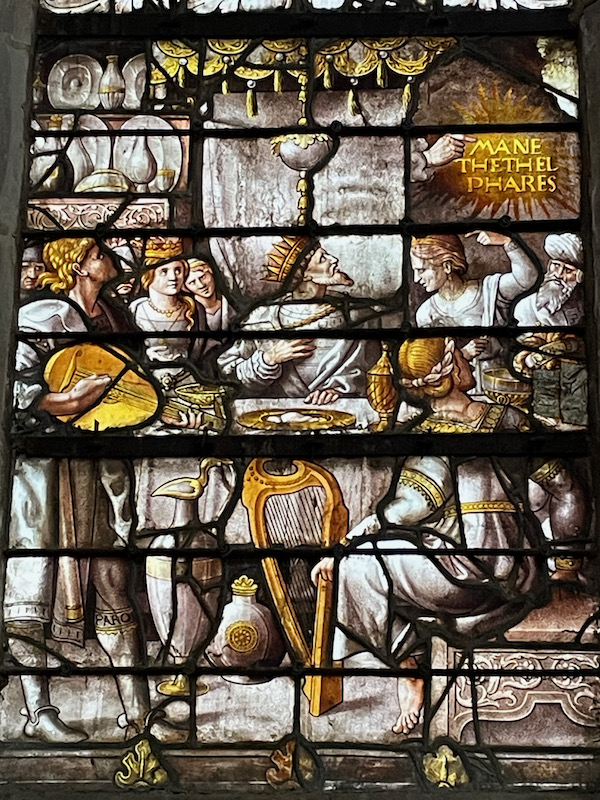
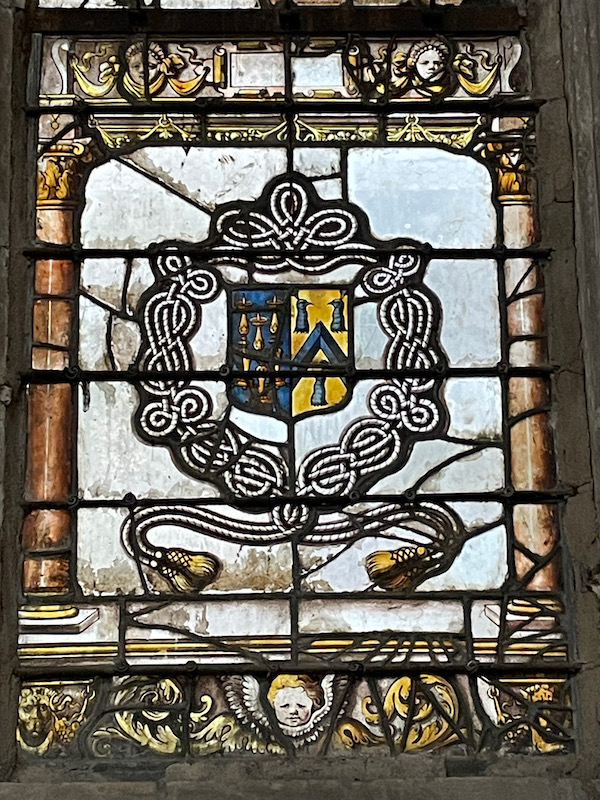
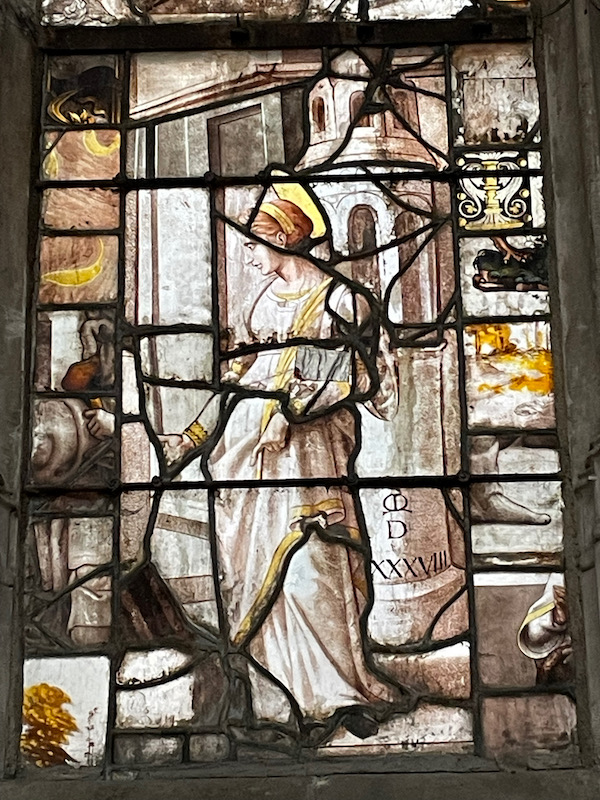
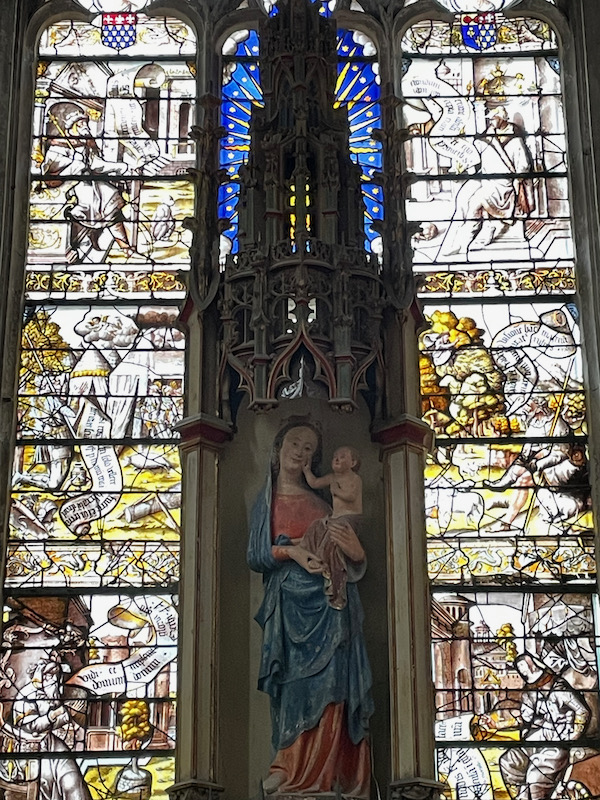
And here is an example where, starting in the 15th century, we started seeing more red and blue, along with the base grey-white-brown-yellow colors.
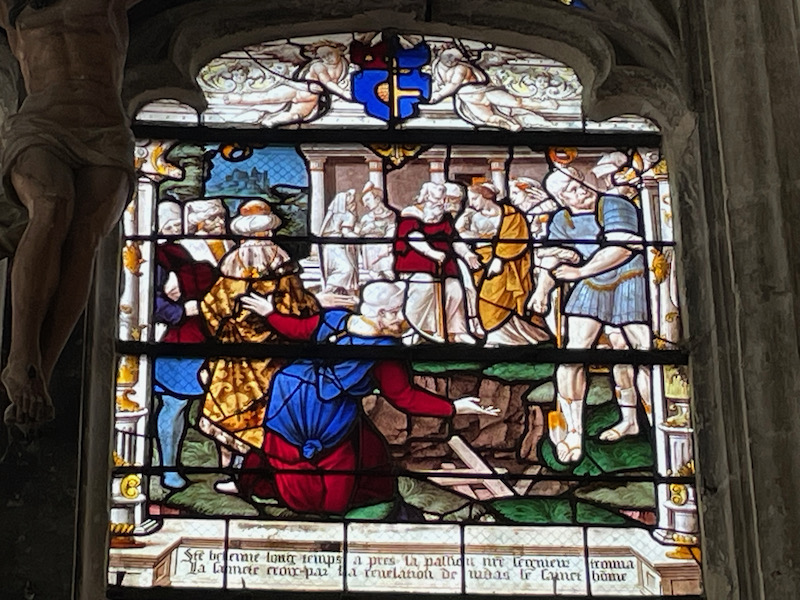
The main altar with a statue of Saint Pantaleon.
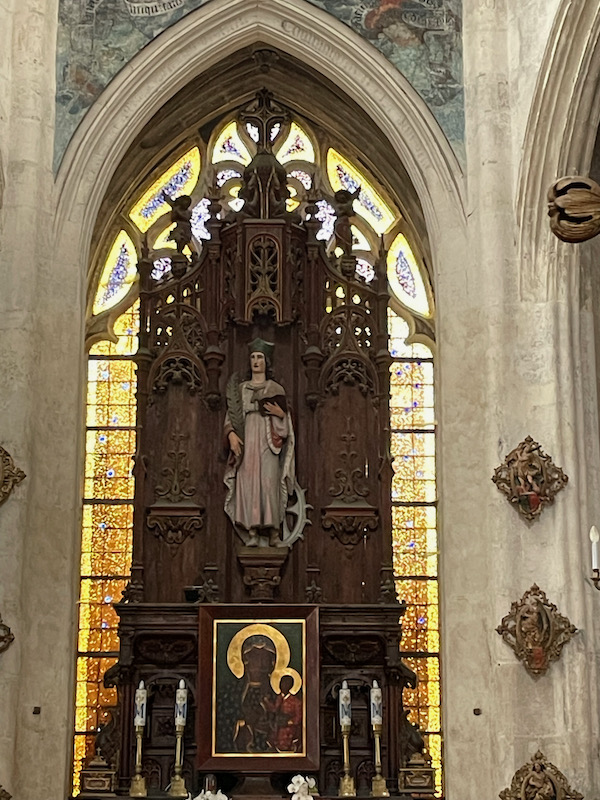
Just across the street from the church is the Hôtel Vauluisant, a private mansion that was originally the guest quarters of the monks of the abbey of Vauluisants. I grabbed pictures of what I could, but the museums were closed and so I couldn't even enter into the courtyard to see the rest of the building.
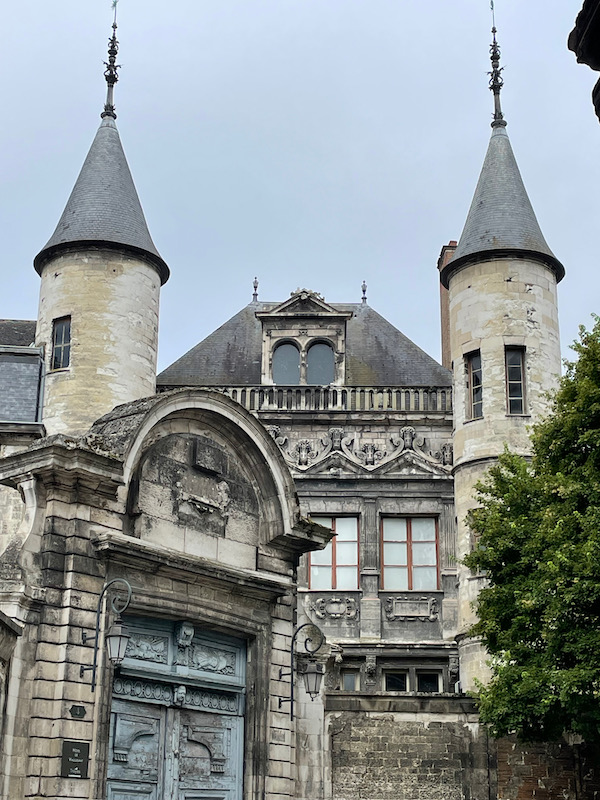
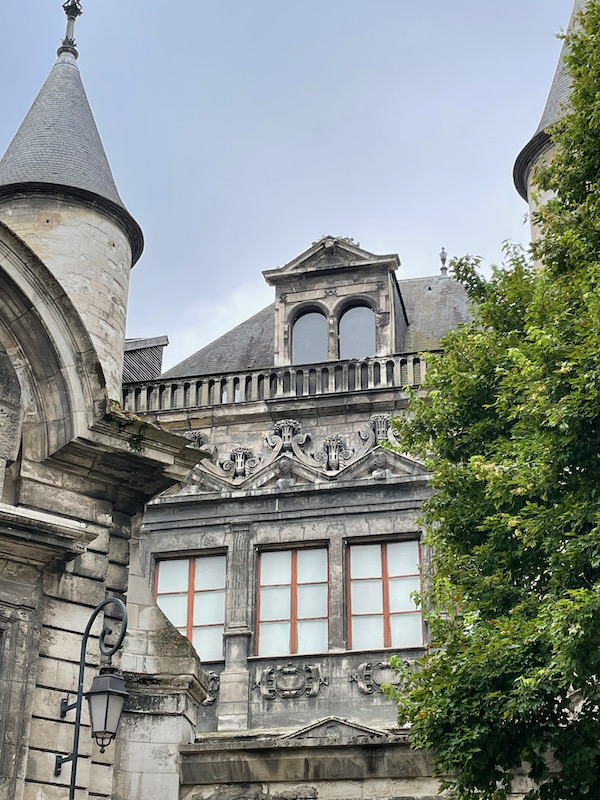
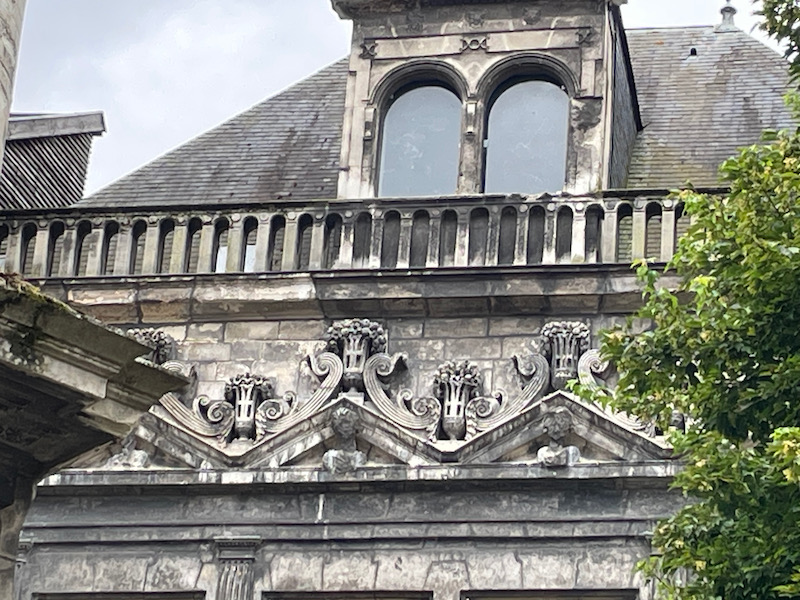
After the great fire of 1524, this private mansion built that was transformed into an orphanage in 1582. It was here that the hosiery industry was born in 1746 when the first power looms were installed and housed the largest manufacturer of stocking knitting machines in the city. It was then turned into a garrison and a print shop before being restored in 1969. It was then turned into one of the largest museums for manual tools in the world, called the "Maison de l'Outil" or "House of Tools".
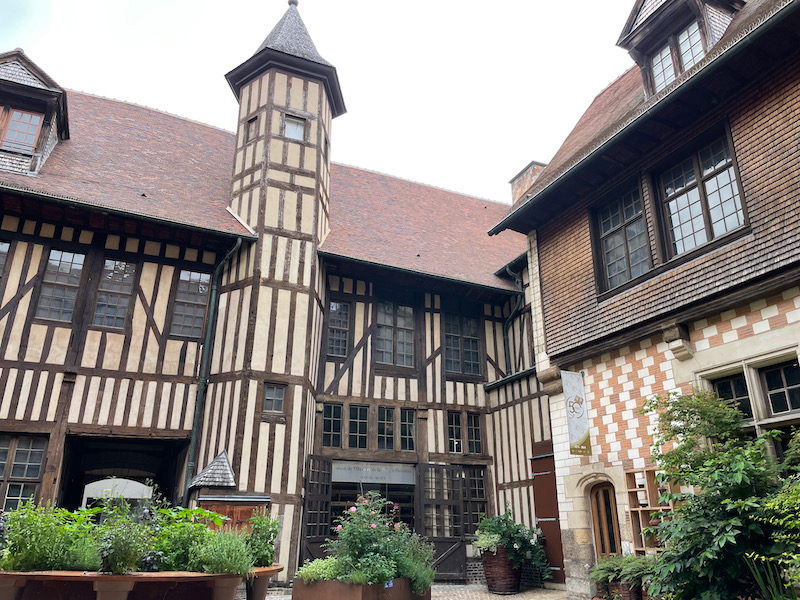
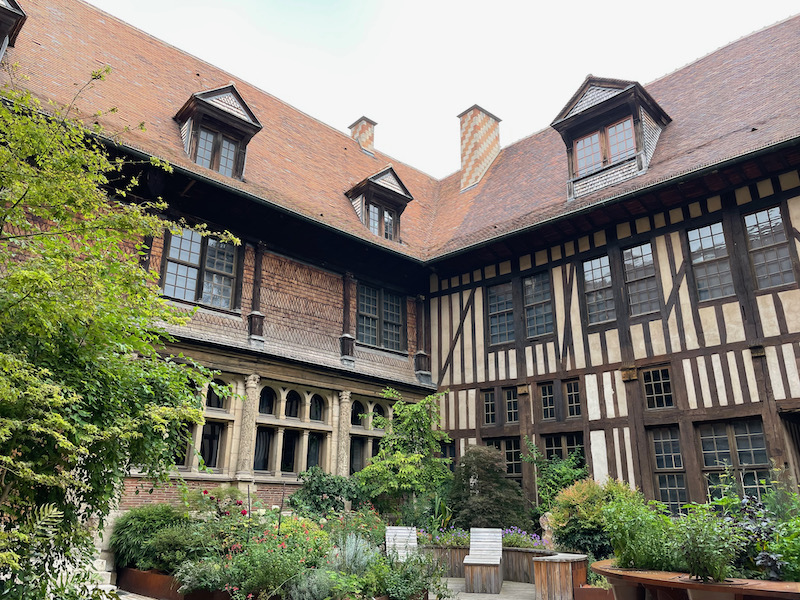
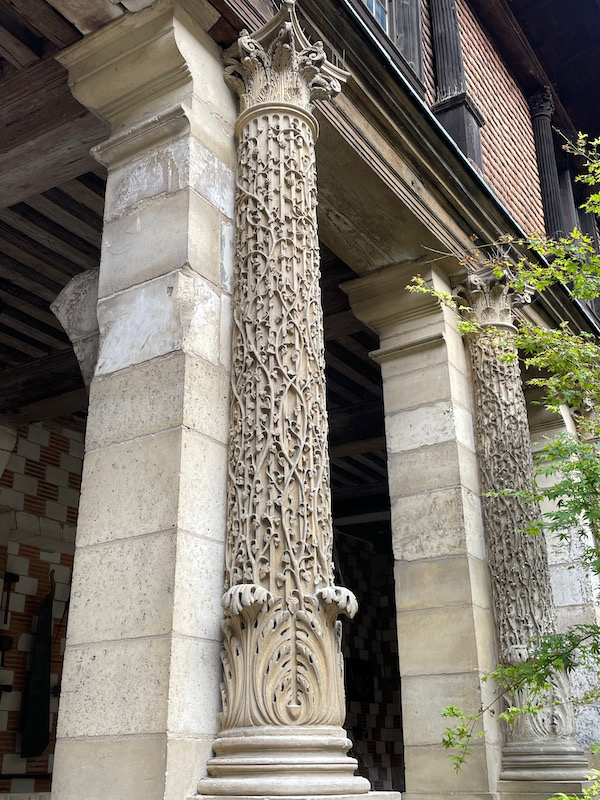
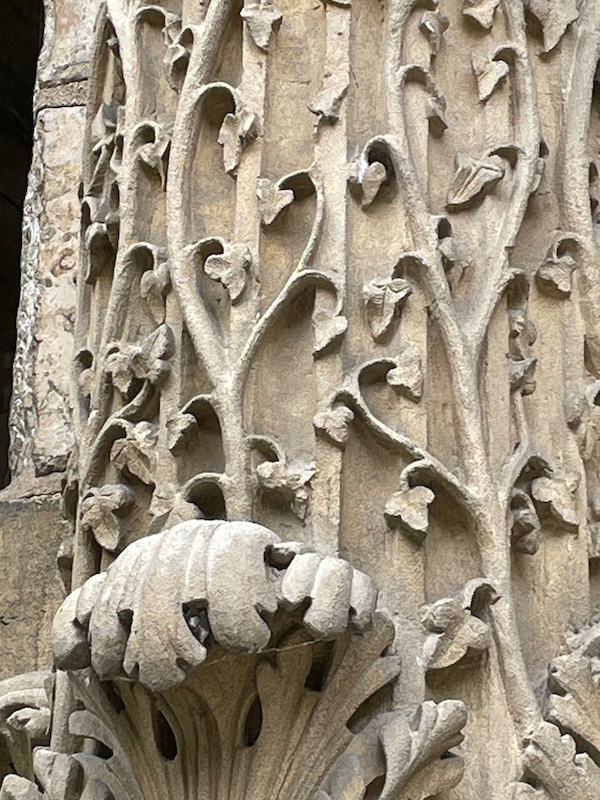
Saint Urbain Basilica was founded by Jacques Pantaléon, who was elected Pope in 1261 under the name of Urbain IV. He decided to build a Basilica on the site of his father’s cobbler’s shop. It was rapidly built between 1262 and 1286, but it took 6 centuries for the stone nave vault to be built. The Pope's remains were later brought back from Italy and placed in the choir in 1935.
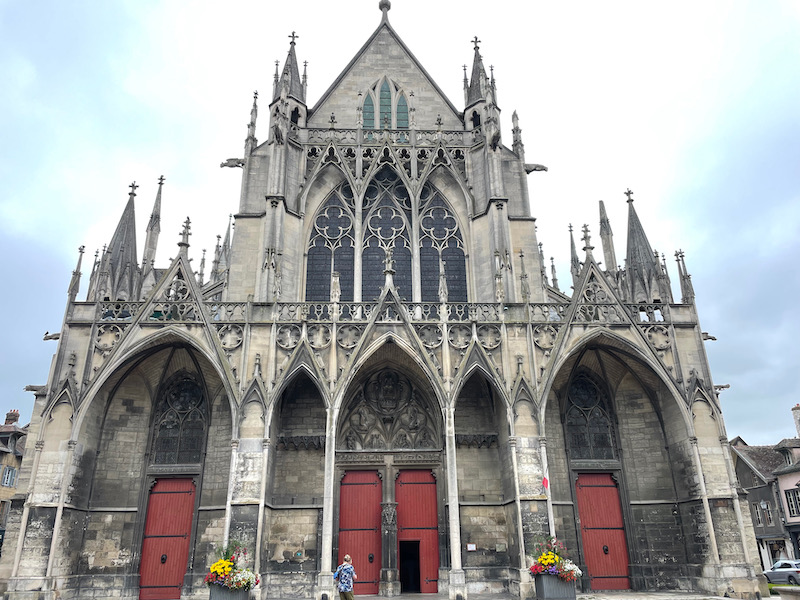
Inside, you have a very typical structure with the high Gothic vaulted nave and the arches going to side aisles.
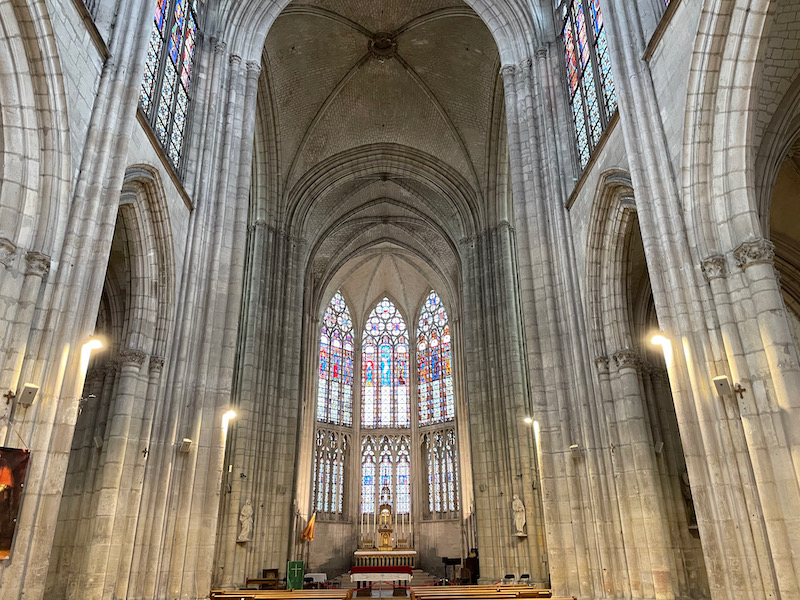
The baptismal font dates from the 15th century.
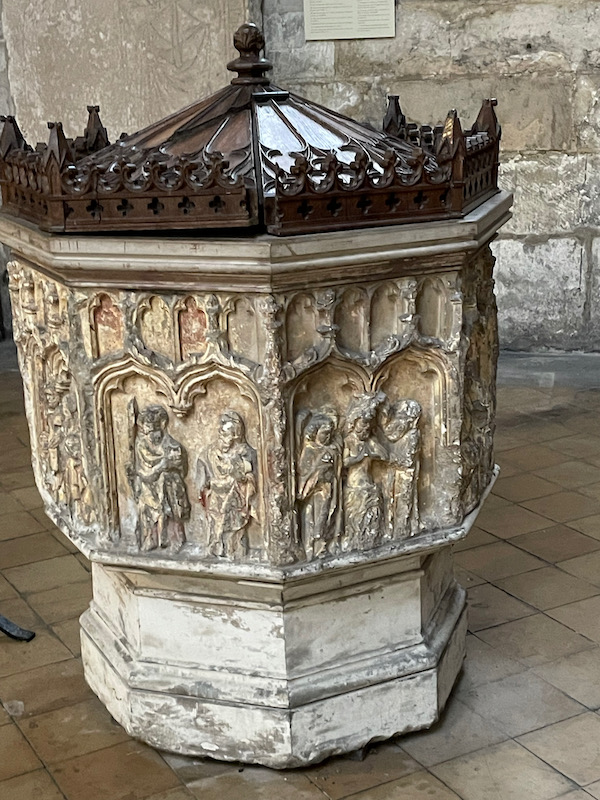
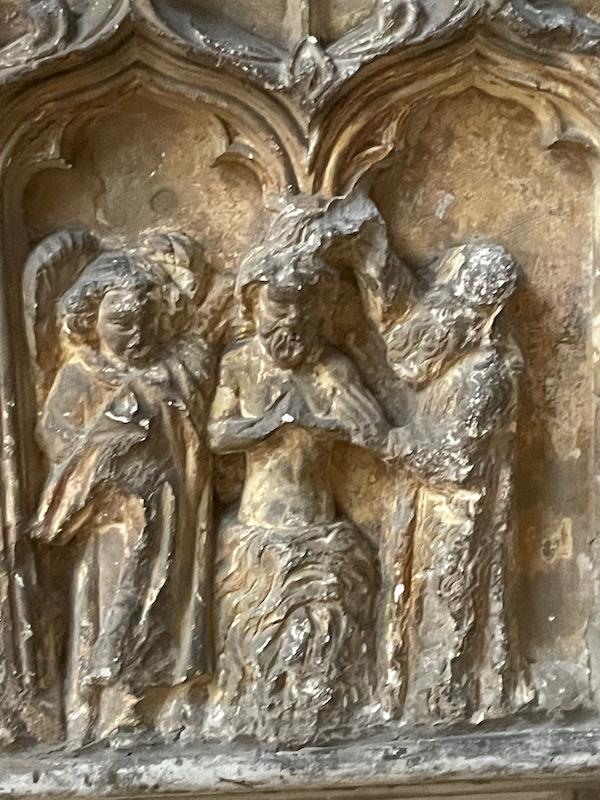
Some of the stained-glass windows are original and date from 1270, although they were renovated in 1992 by a local stained-glass workshop.
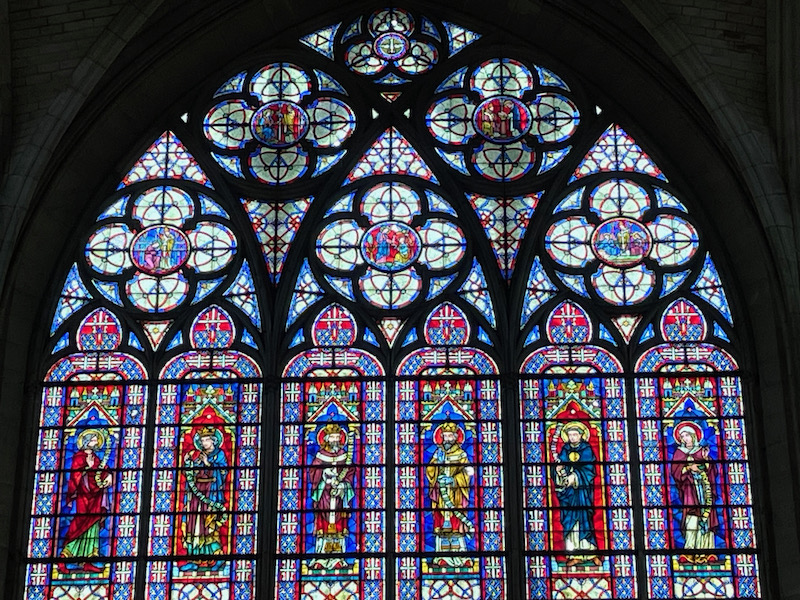
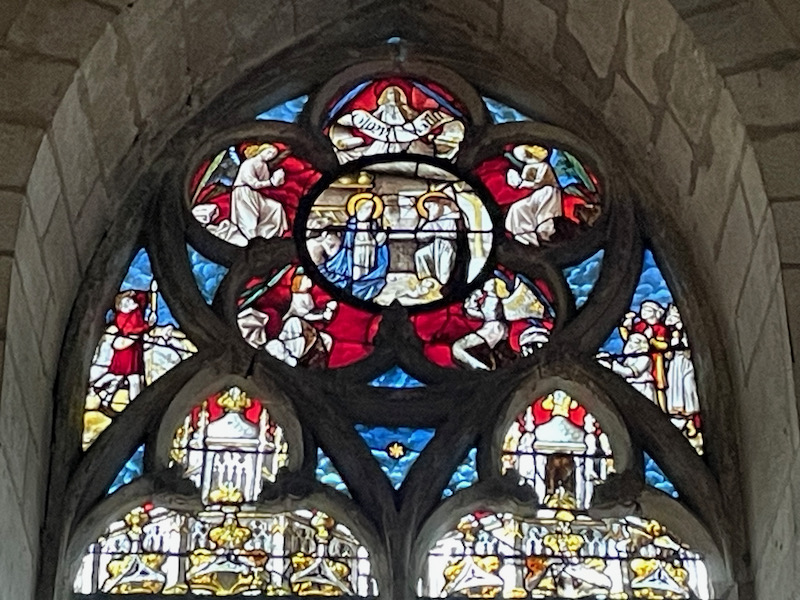
The carved wooden altar also is very Gothic in nature.
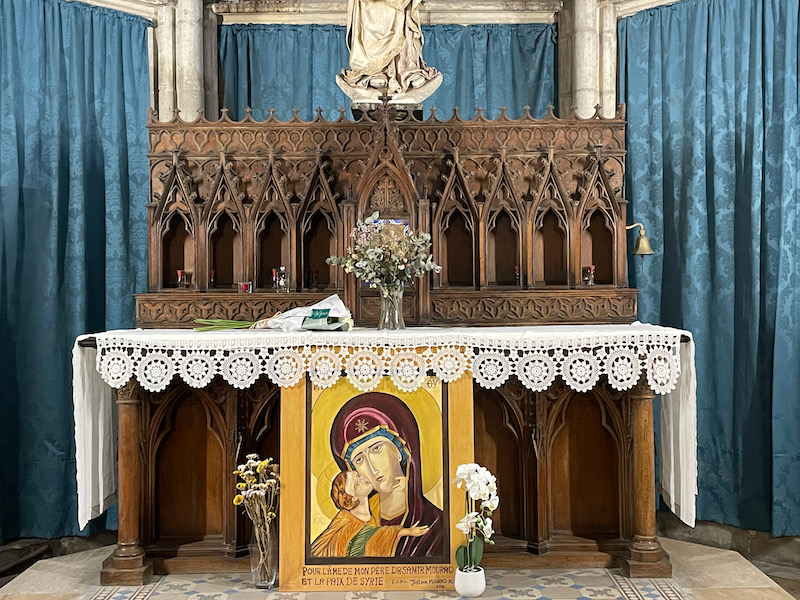
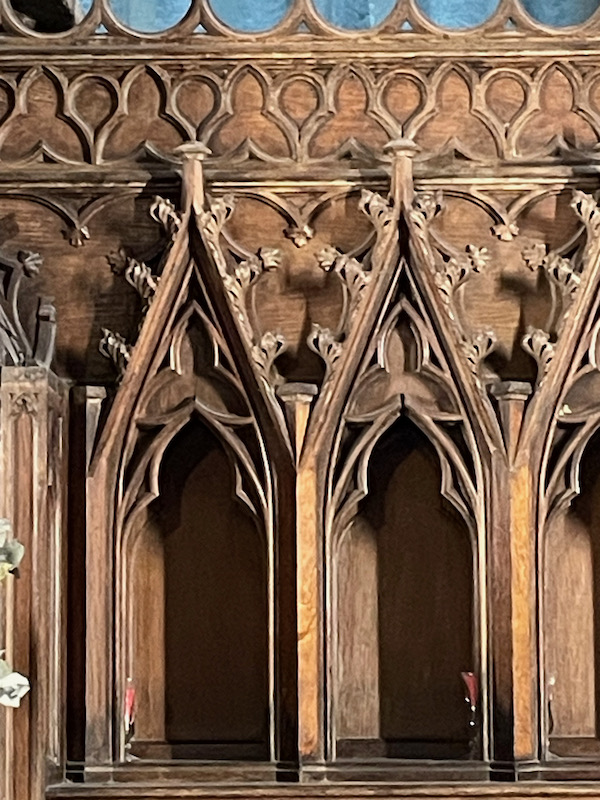
The Saint Pierre and Saint Paul Cathedral was built over a 400-year period starting in 1208 and is recognizable among thousands of cathedrals because of the unique single tower on the left. This is called the Saint Peter tower, which was finished in the 17th century. Very Gothic architecture although if you know Gothic well (which we do not), there are several different stages of Gothic used due to the very long construction period. The tympanums over the 3 portals are empty because they were destroyed during the French Revolution. Another unique feature is the large clock on the face of the tower. You can also see that they are in the middle of a cleaning ... look at the last picture and compare the right-and-left. What a difference a nice cleaning makes!
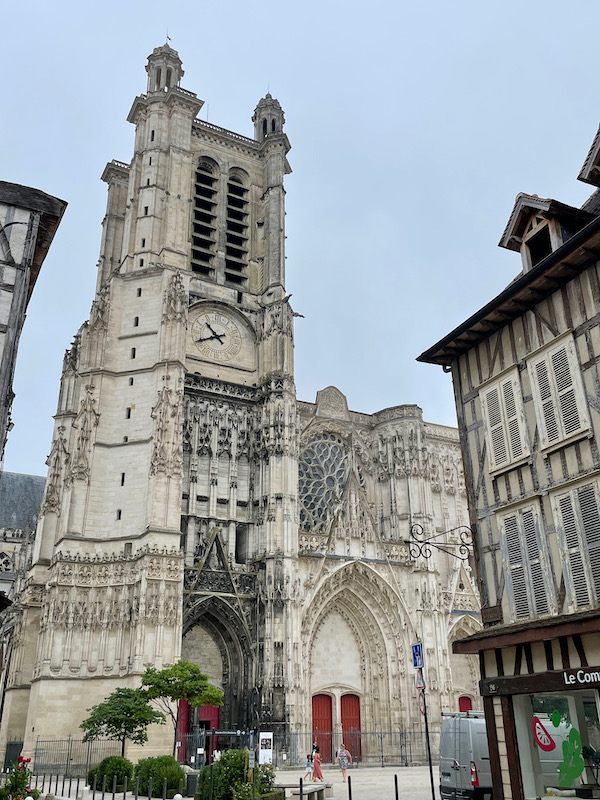
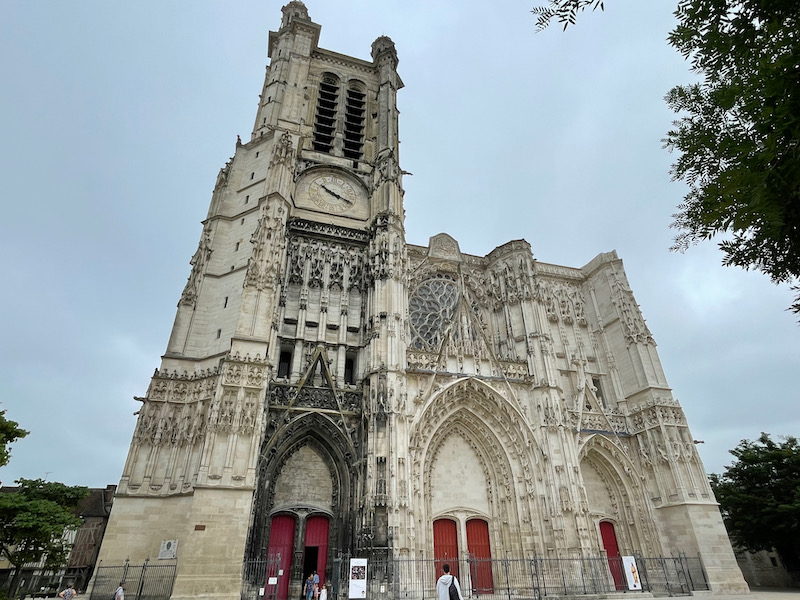
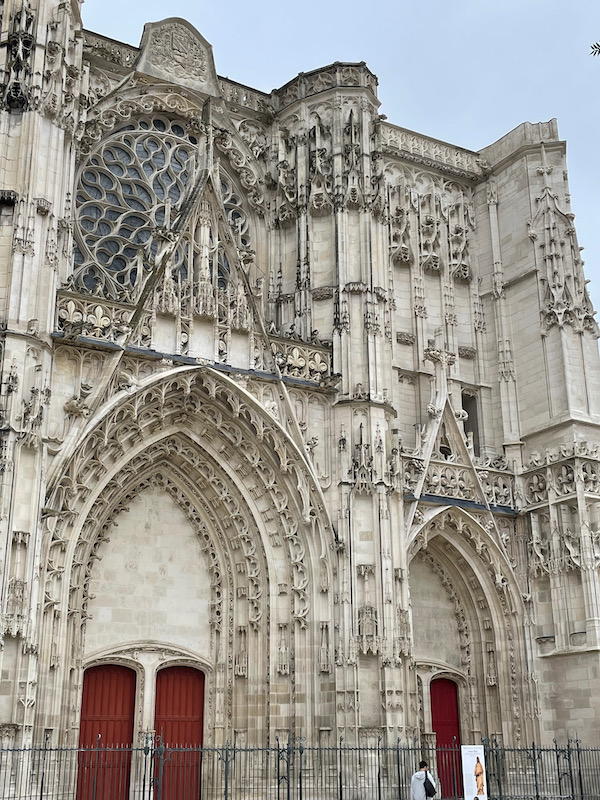
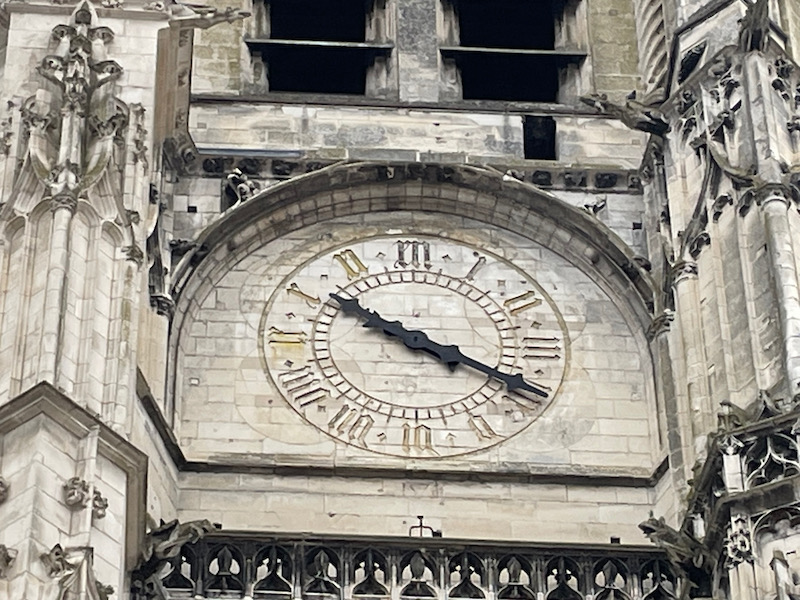
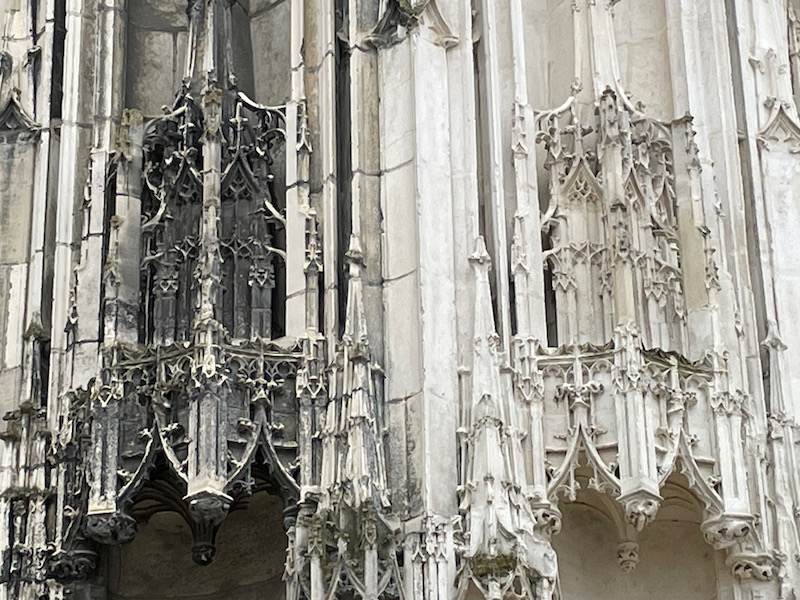
Looking down the nave, we can clearly see the Gothic arches and ribbed vaults, along with the stained-glass windows on the upper levels. The side chapels were not included in the original plan and some are enclosed with large stone gates.

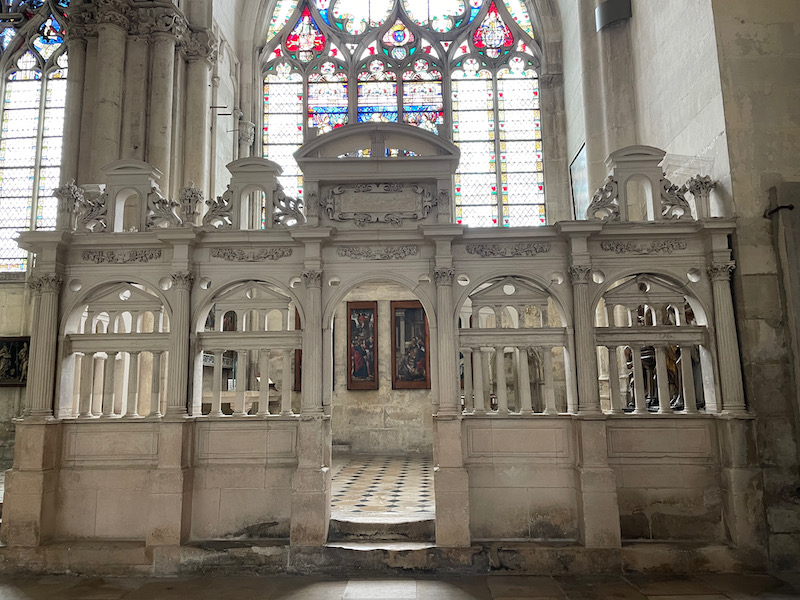
The stained glass windows of Troyes Cathedral are considered a major work of glass painting in France. Since their first installation, some of the windows have received significant restorations and others only minor changes. While some of the glass compositions have been destroyed by bad weather, others have been moved from one bay to another. This required using pieces of a broken window and transferring it to another. The stained-glass in the choir date from the 13th century and depict the victory of the New Testament over the Old Testament. Most of the windows are very colorful but there are a few grisailles as well. The rose windows and windows in the nave date from the 15th century.
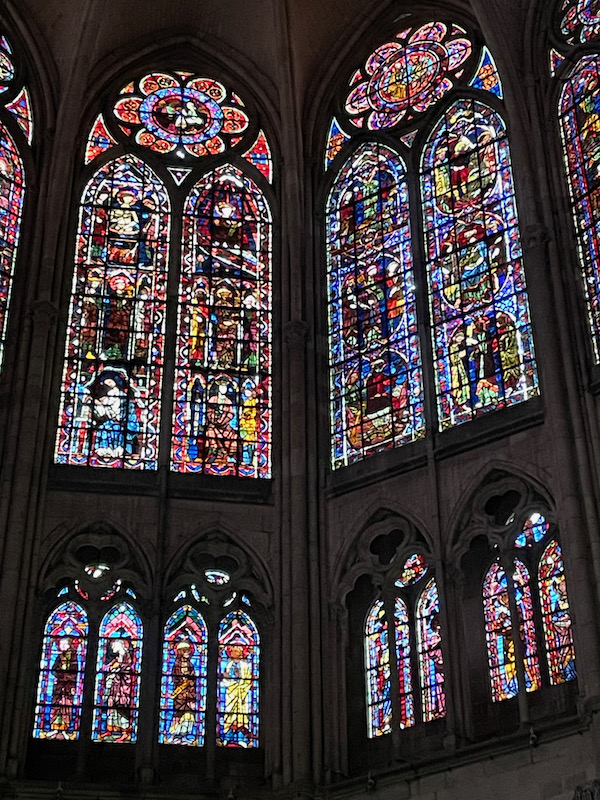
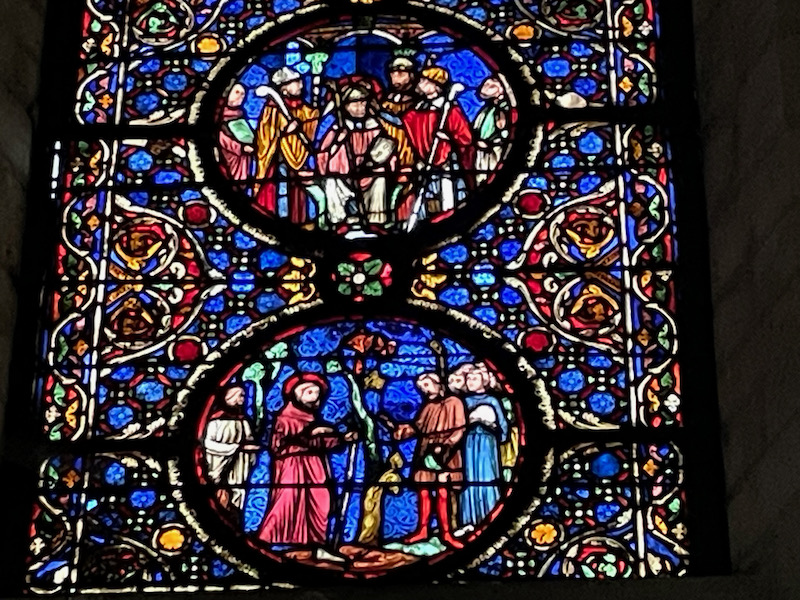
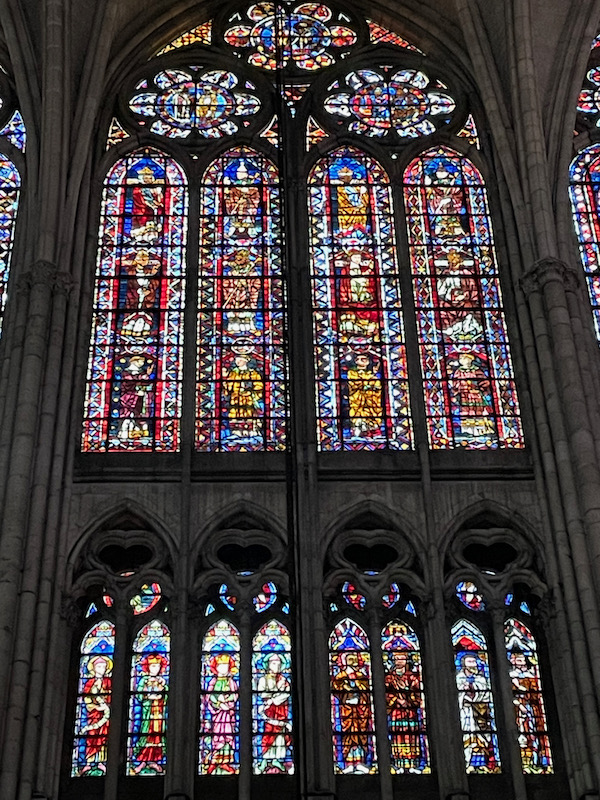
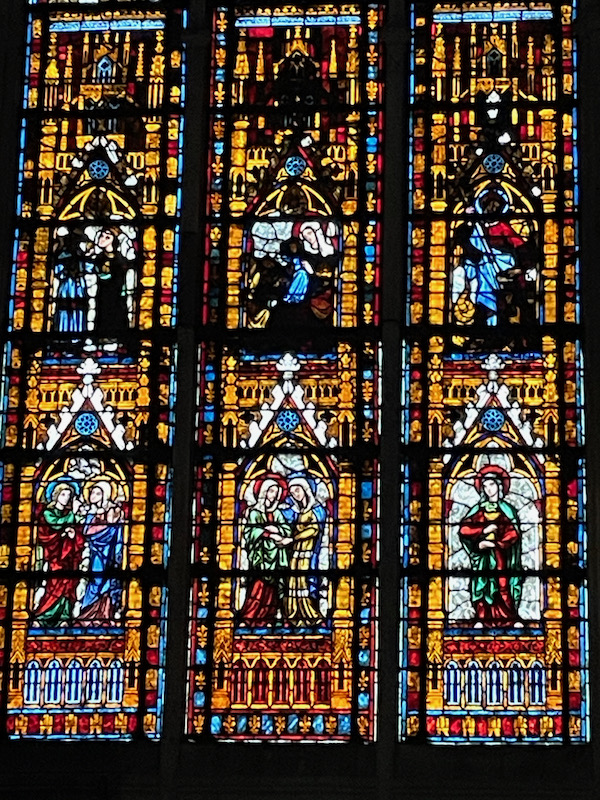
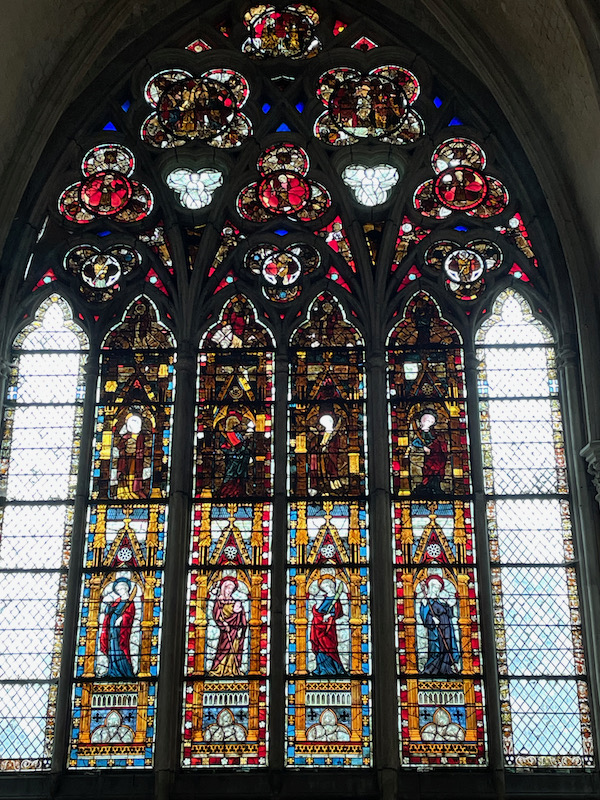
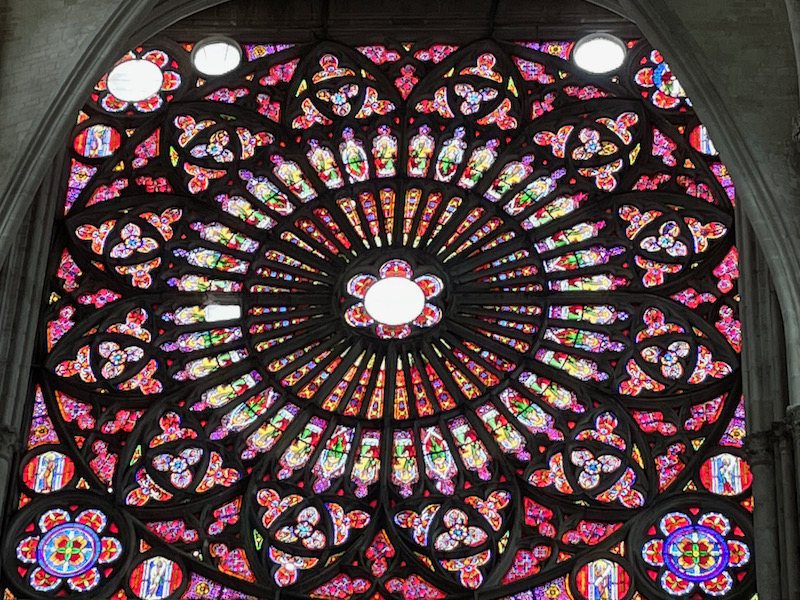
Up on the upper tiers, there are also windows behind the Gothic tracery. Some of the shapes are pretty interesting ...if you look closely, you can find the French Fleur des Lys in the tracery of the 2nd picture.
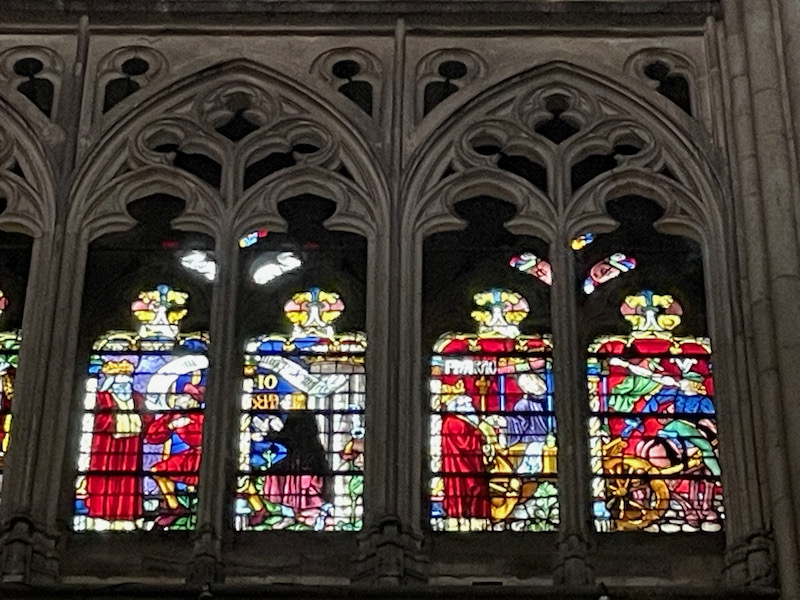
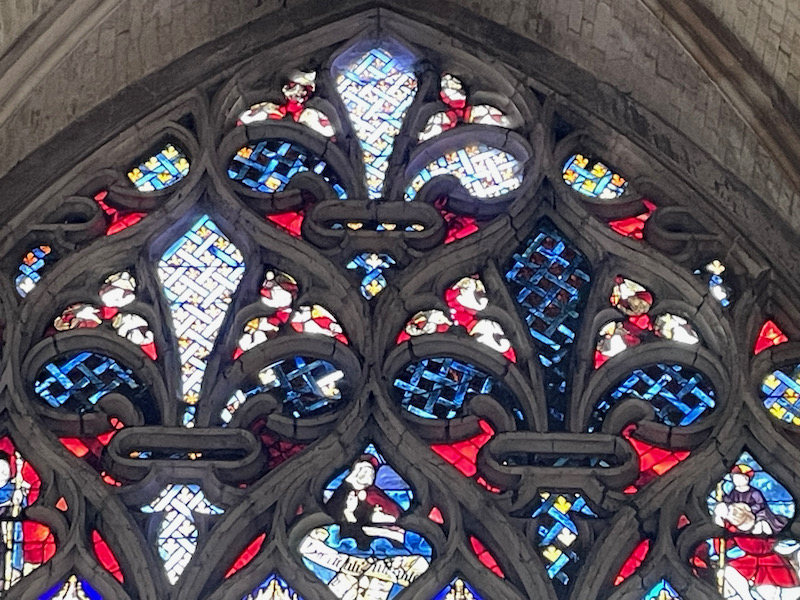
These three videos were my mediocre attempt to give you an idea of just how much stained-glass is in this church. The first two show the right and left sides of the nave and then the 3rd goes from the left transept and its rose window, through the choir, and then the right transept and its rose window. The goal (which I seem to have accomplished) is not to really be able to see each window and what is shown in the window, but more just the sheer volume and colors of the windows.
This is the top of the stained-glass window of the "Mystique Pressoir". You can see the dates when it was created, which is 1625 (initially I thought 1025!). It has vines and grapes which is an extension of the Church (Christ is the vine, the branches are his disciples). The 17th century was marked by this type of iconography, which was inspired by the iconography of the tree of Jesse.
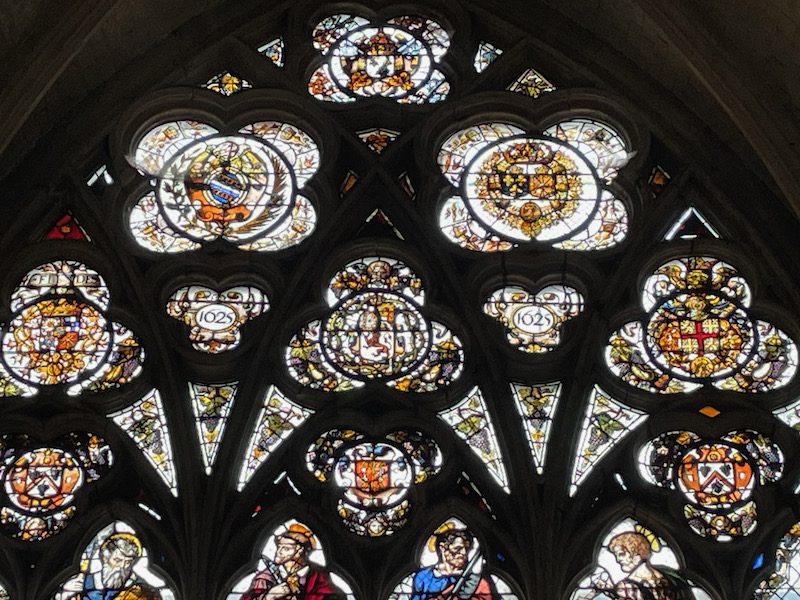
This is a quite nice piece ... one of the altars that seems quite old, with painted figures across the middle band.
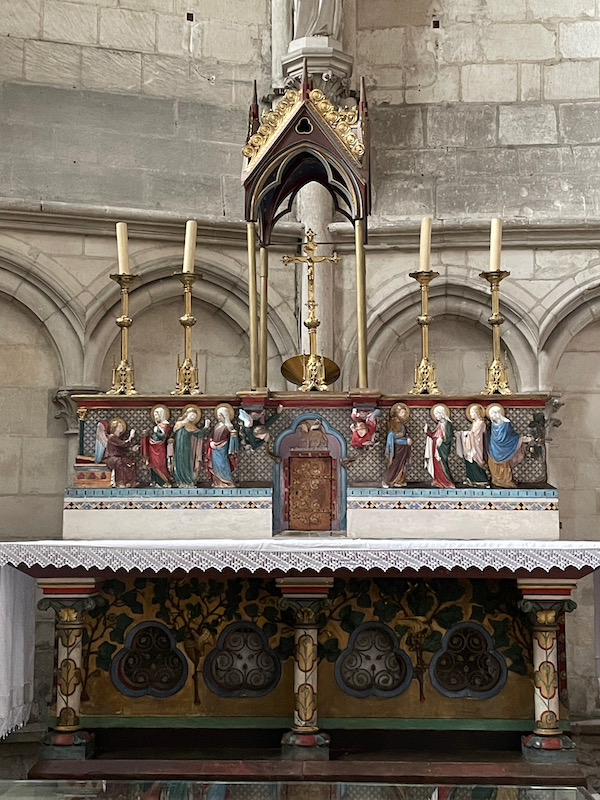
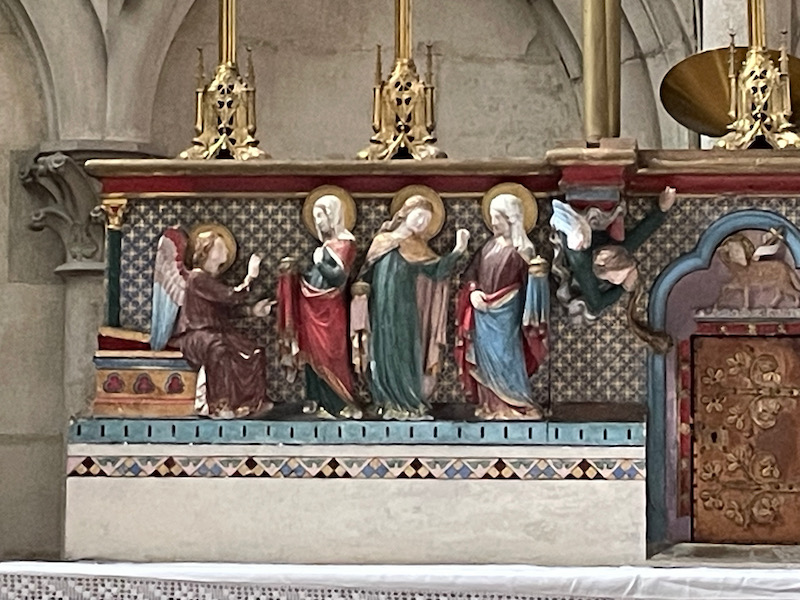
Lucy was quite patient waiting while we took turns inside.
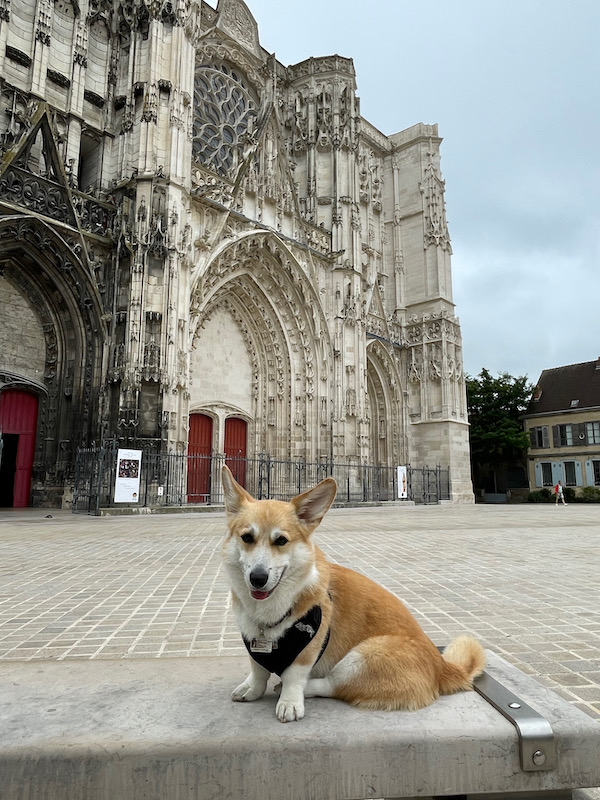
This cute sculpture group, entitled “Wait for me”, is one of 2 bronze sculptures from the Belgian artist Tom Frantzen. This humorous and poetic work presents a small dog (on the left, jumping from the bridge) that scares a group of birds and causes them to fly away. This group recalls the cranes that fly over this department each year.
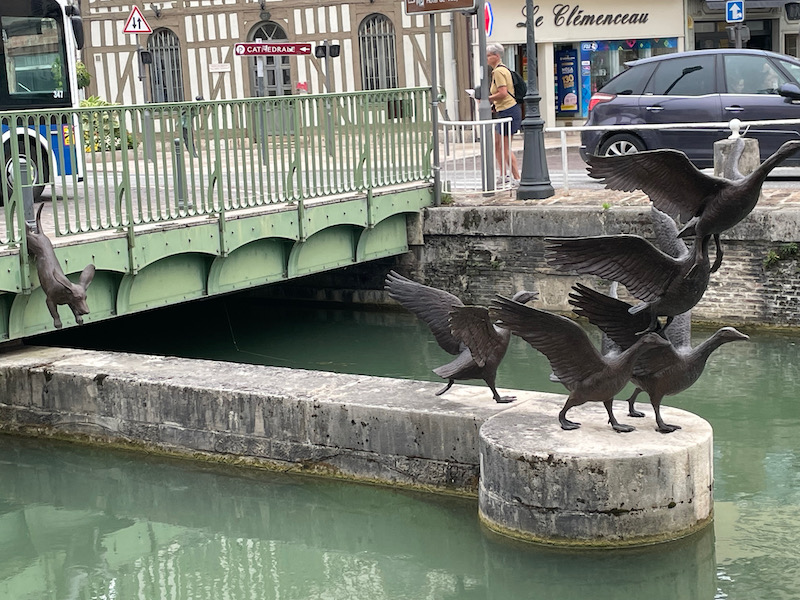
The city of Troyes is in the "heart" of the Champagne region and so they have placed a "heart" here in the old town. This big heart is made from stainless steel lace and it "beats" and turns red at nightfall. It has become the new emblem of the city and the mascot of the inhabitants. Lucy thought it was a really cool looking piece of art!

Sainte Madeleine Church is perhaps the oldest church in town. The nave was built in the 13th century, choir and apse rebuilt in the 16th, and the tower added in the 17th century. The outside is not that interesting, but inside is much better.
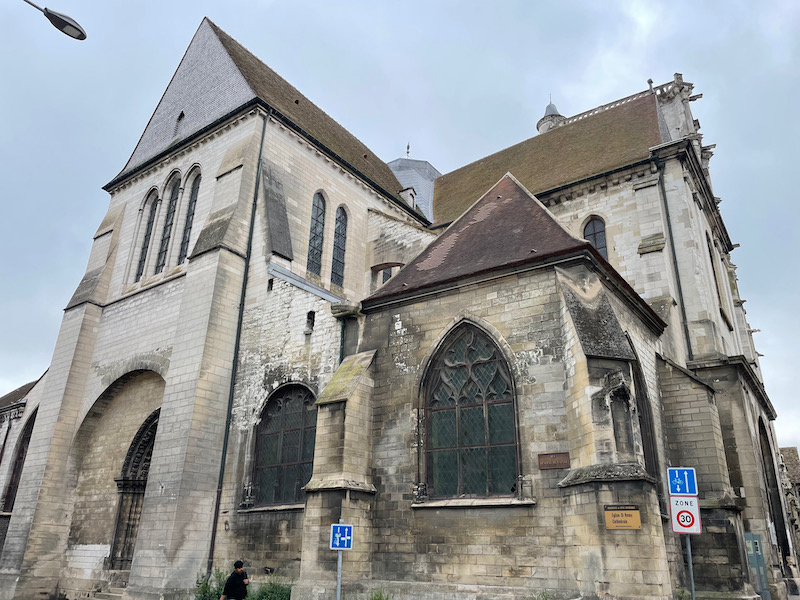
Here is the interior view, showing the nave, with the Gothic arches separating the nave from the side aisles. In front is the very high Gothic vaults and, across the middle, you can see the Rood Screen.
Probably the most impressive part of the church is the rood screen. The rood screen is a kind of gallery that acts as a "screen" to separate the choir from the nave, or the clegy from the laymen. There aren't many rood screens left because, as churches evolved, they no longer wanted to have this separation. This Flamboyant Gothic rood screen was created in the 16th century when the church wanted to renovate its old wooden rood screen. It was created out of limestone between 1508 and 1517 (the mason who did it died 2 years later and is buried underneath it). It was originally fully painted and very colorful, but now only a few places still have the paint (a couple statues).
I attempted to do a video going around it to show it and then a few static pictures. Hopefully, you get an idea of how impressive this is.
This is the clergy-side of the rood screen ... which is not as decorated.
This high-relief in painted wood showing The Calvary dates from the middle of the 16th century. There are soldiers on horseback, and the Virgin Mary collapsing into the arms of St John and Mary Magdalene (center-left). The donor (the person who paid to have this created and donated to the church) is seen at the bottom left, shown as a priest who is praying.
There are also several lovely stained-glass windows here, most dating to around 1518, and the church had quite a bit of information on each one (thankfully). This first one is called "The Triumph of the Cross" and shows various scenes including the sacrifice of Abraham, Moses and the burning bush, and St. John the Baptist. The two close-ups I have are (first) the Baptizing of the Emperor Constantine, and (second) the discovery of the cross by St. Helen, the Emperor's mother.
In the window that details the life of Saint Mary Magdalene, dating from 1506, are panels that show the Raising of Lazarus from the dead and the Last Communion of Mary Magdalene.
Here is one that illustrates the tree of Jesse.
And my last window, circa 1500, details the book of Genesis. Across the bottom, we see The world, then the sky and earth, the the separation of the elements (this is the detail pane), and finally, the stars.
The row about that shows God creating the fish and birds, the other animals (the detail pane), and then Adam and Eve.
And this pane shows Cain killing Abel.
